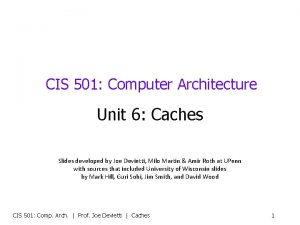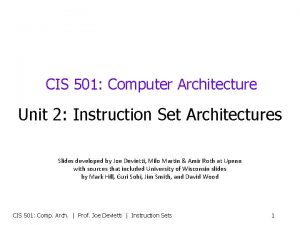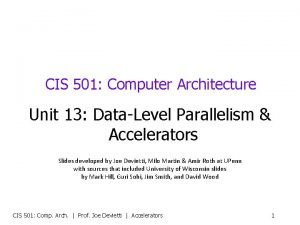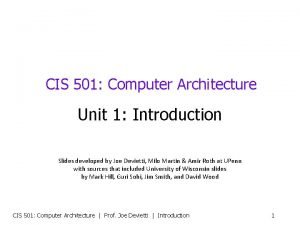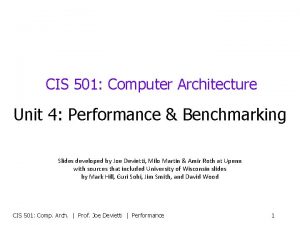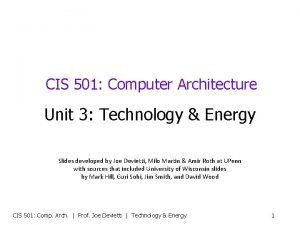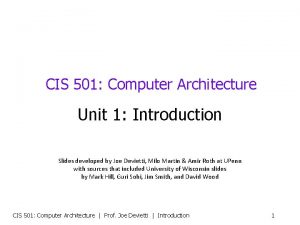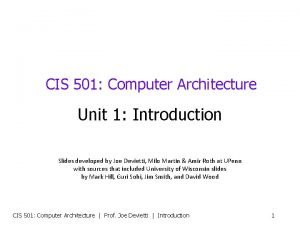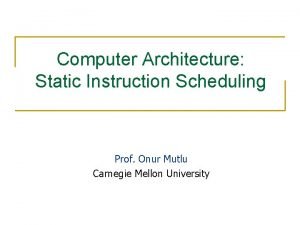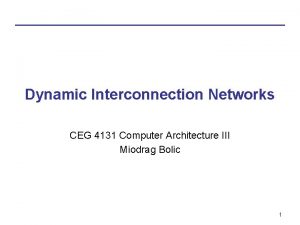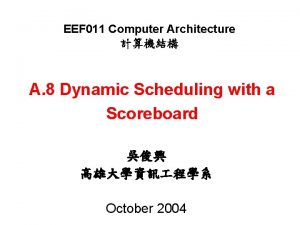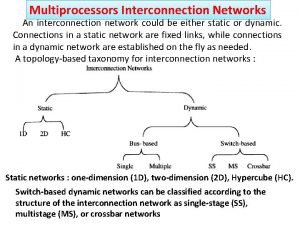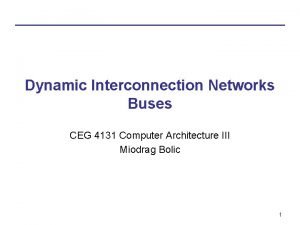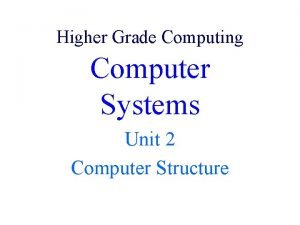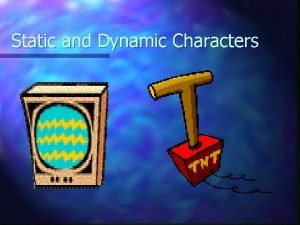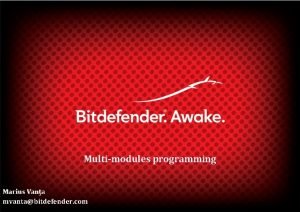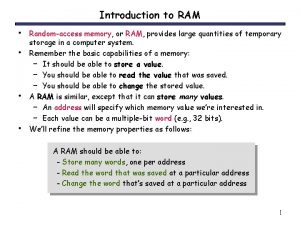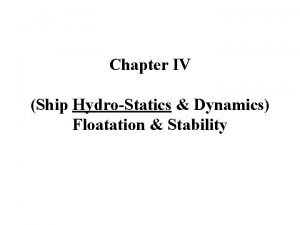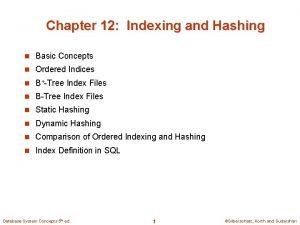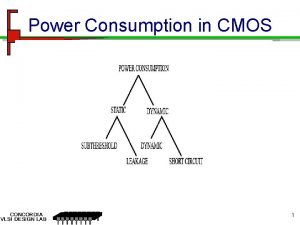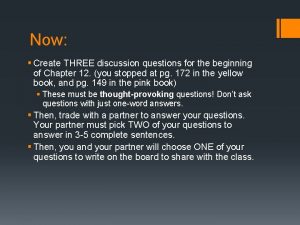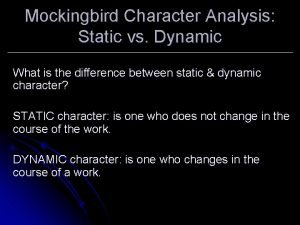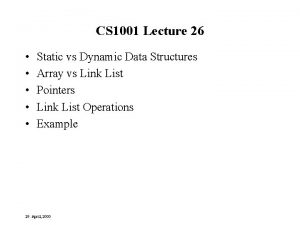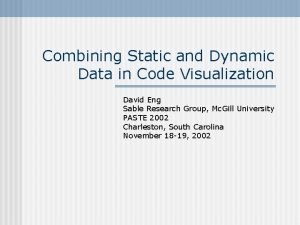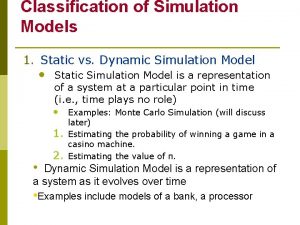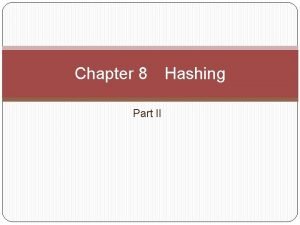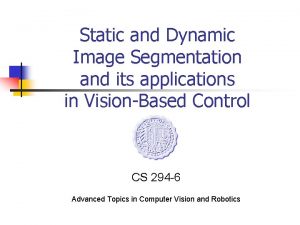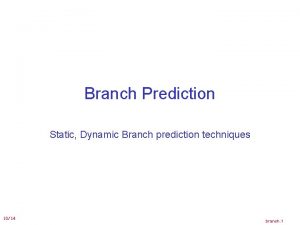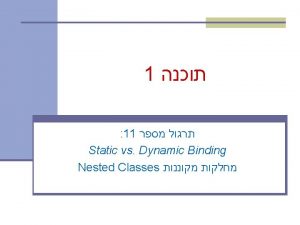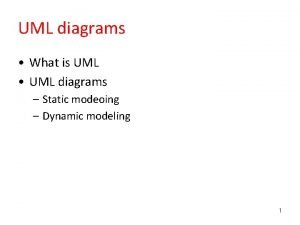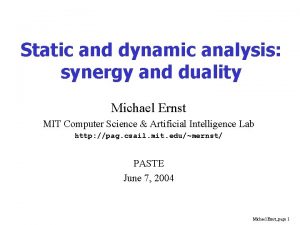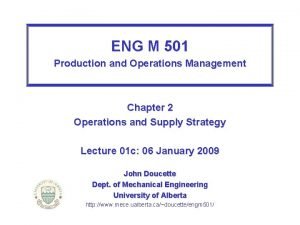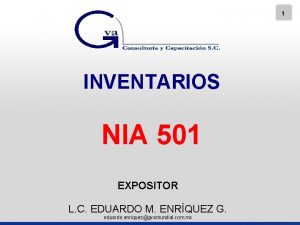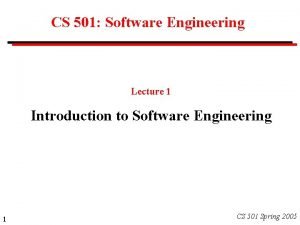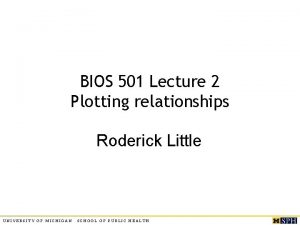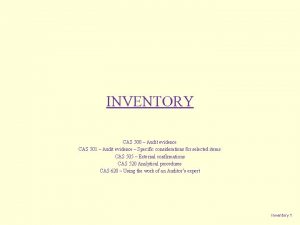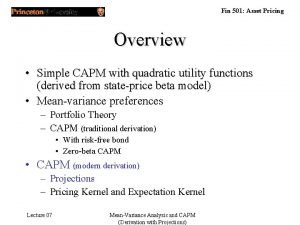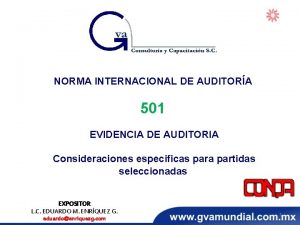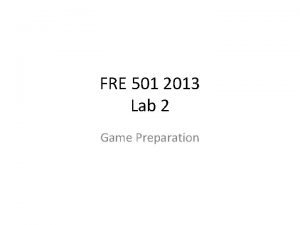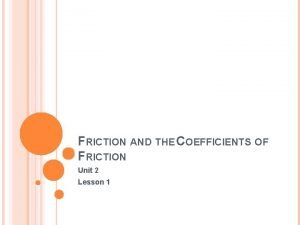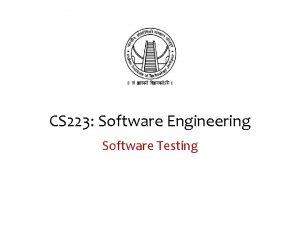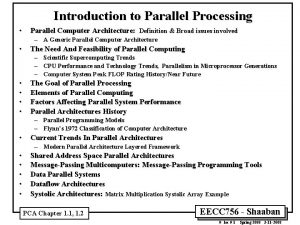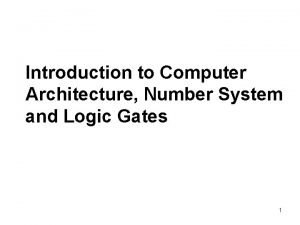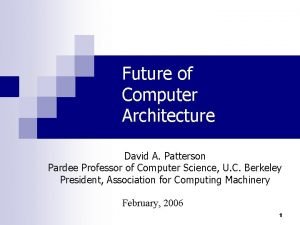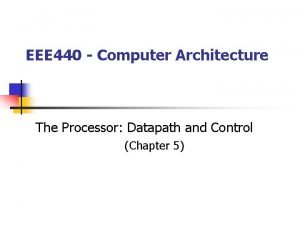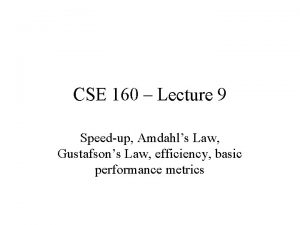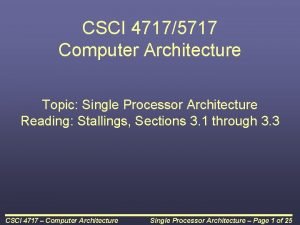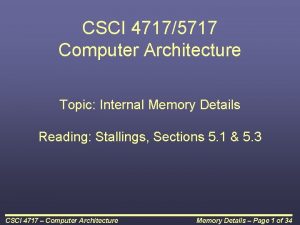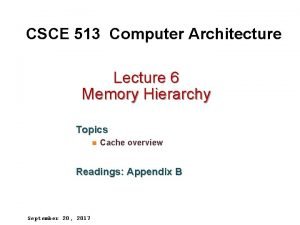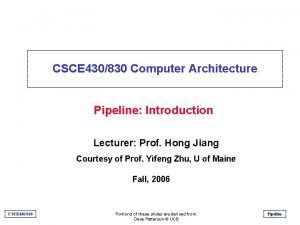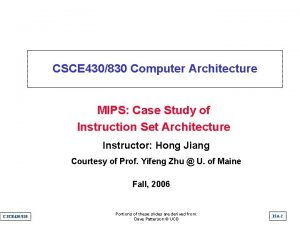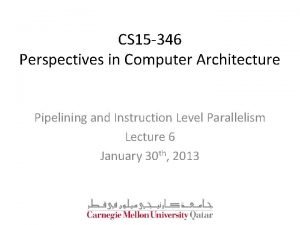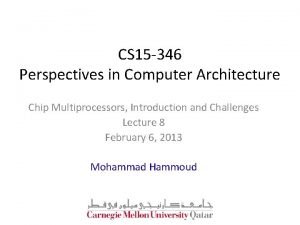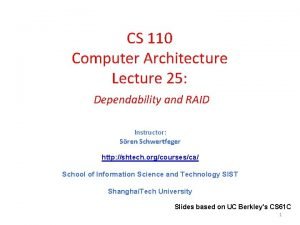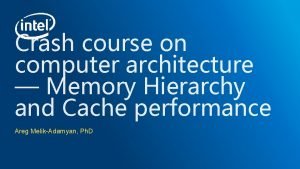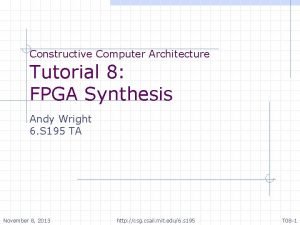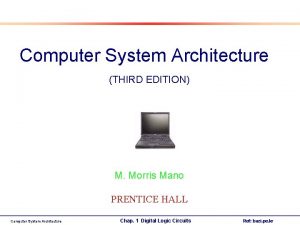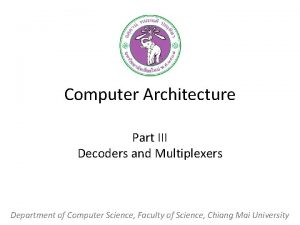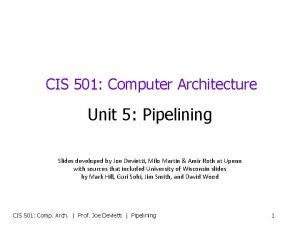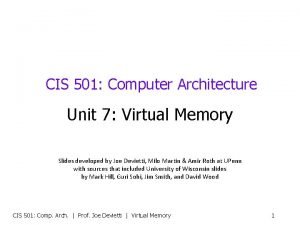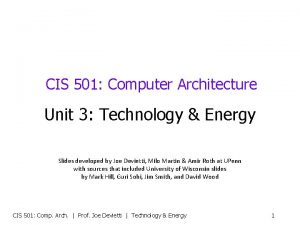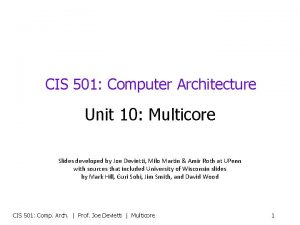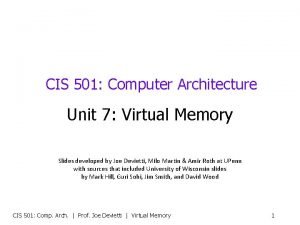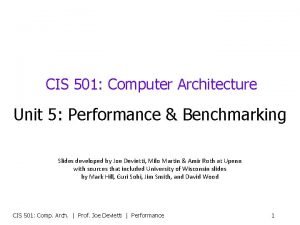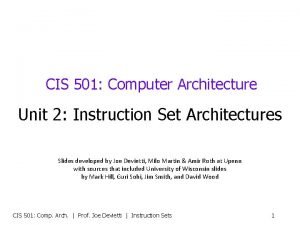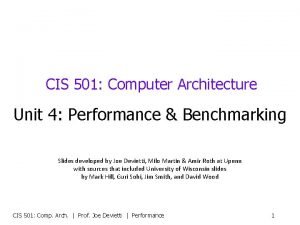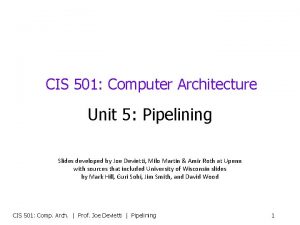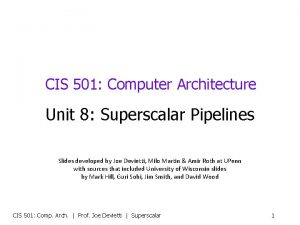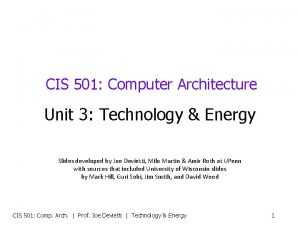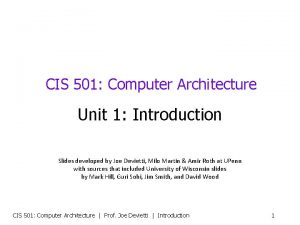CIS 501 Computer Architecture Unit 9 Static Dynamic
















![Example: In-Order Limitations #1 0 1 2 3 4 5 Ld [r 1] ➜ Example: In-Order Limitations #1 0 1 2 3 4 5 Ld [r 1] ➜](https://slidetodoc.com/presentation_image_h2/7d953ba5a8867ad793e4aed8af594e9c/image-17.jpg)
![Example: In-Order Limitations #2 0 1 2 3 4 5 Ld [p 1] ➜ Example: In-Order Limitations #2 0 1 2 3 4 5 Ld [p 1] ➜](https://slidetodoc.com/presentation_image_h2/7d953ba5a8867ad793e4aed8af594e9c/image-18.jpg)





![Register Renaming Algorithm • Two key data structures: • maptable[architectural_reg] physical_reg • Free list: Register Renaming Algorithm • Two key data structures: • maptable[architectural_reg] physical_reg • Free list:](https://slidetodoc.com/presentation_image_h2/7d953ba5a8867ad793e4aed8af594e9c/image-24.jpg)


![Dynamic Scheduling/Issue Algorithm • Data structures: • Ready table[phys_reg] yes/no (part of “issue queue”) Dynamic Scheduling/Issue Algorithm • Data structures: • Ready table[phys_reg] yes/no (part of “issue queue”)](https://slidetodoc.com/presentation_image_h2/7d953ba5a8867ad793e4aed8af594e9c/image-27.jpg)

![Register Renaming Algorithm (Simplified) • Two key data structures: • maptable[architectural_reg] physical_reg • Free Register Renaming Algorithm (Simplified) • Two key data structures: • maptable[architectural_reg] physical_reg • Free](https://slidetodoc.com/presentation_image_h2/7d953ba5a8867ad793e4aed8af594e9c/image-29.jpg)























![Dynamic Scheduling/Issue Algorithm • Data structures: • Ready table[phys_reg] yes/no (part of issue queue) Dynamic Scheduling/Issue Algorithm • Data structures: • Ready table[phys_reg] yes/no (part of issue queue)](https://slidetodoc.com/presentation_image_h2/7d953ba5a8867ad793e4aed8af594e9c/image-53.jpg)














![Register Renaming Algorithm (Full) • Two key data structures: • maptable[architectural_reg] physical_reg • Free Register Renaming Algorithm (Full) • Two key data structures: • maptable[architectural_reg] physical_reg • Free](https://slidetodoc.com/presentation_image_h2/7d953ba5a8867ad793e4aed8af594e9c/image-68.jpg)






























![Out-of-Order Pipeline – Cycle 0 0 ld [r 1] ➜ r 2 F add Out-of-Order Pipeline – Cycle 0 0 ld [r 1] ➜ r 2 F add](https://slidetodoc.com/presentation_image_h2/7d953ba5a8867ad793e4aed8af594e9c/image-99.jpg)
![Out-of-Order Pipeline – Cycle 1 a 0 1 ld [r 1] ➜ r 2 Out-of-Order Pipeline – Cycle 1 a 0 1 ld [r 1] ➜ r 2](https://slidetodoc.com/presentation_image_h2/7d953ba5a8867ad793e4aed8af594e9c/image-100.jpg)
![Out-of-Order Pipeline – Cycle 1 b 0 1 ld [r 1] ➜ r 2 Out-of-Order Pipeline – Cycle 1 b 0 1 ld [r 1] ➜ r 2](https://slidetodoc.com/presentation_image_h2/7d953ba5a8867ad793e4aed8af594e9c/image-101.jpg)
![Out-of-Order Pipeline – Cycle 1 c 0 1 ld [r 1] ➜ r 2 Out-of-Order Pipeline – Cycle 1 c 0 1 ld [r 1] ➜ r 2](https://slidetodoc.com/presentation_image_h2/7d953ba5a8867ad793e4aed8af594e9c/image-102.jpg)
![Out-of-Order Pipeline – Cycle 2 a 0 1 2 ld [r 1] ➜ r Out-of-Order Pipeline – Cycle 2 a 0 1 2 ld [r 1] ➜ r](https://slidetodoc.com/presentation_image_h2/7d953ba5a8867ad793e4aed8af594e9c/image-103.jpg)
![Out-of-Order Pipeline – Cycle 2 b 0 1 2 ld [r 1] ➜ r Out-of-Order Pipeline – Cycle 2 b 0 1 2 ld [r 1] ➜ r](https://slidetodoc.com/presentation_image_h2/7d953ba5a8867ad793e4aed8af594e9c/image-104.jpg)
![Out-of-Order Pipeline – Cycle 2 c 0 1 2 ld [r 1] ➜ r Out-of-Order Pipeline – Cycle 2 c 0 1 2 ld [r 1] ➜ r](https://slidetodoc.com/presentation_image_h2/7d953ba5a8867ad793e4aed8af594e9c/image-105.jpg)
![Out-of-Order Pipeline – Cycle 3 0 1 2 3 ld [r 1] ➜ r Out-of-Order Pipeline – Cycle 3 0 1 2 3 ld [r 1] ➜ r](https://slidetodoc.com/presentation_image_h2/7d953ba5a8867ad793e4aed8af594e9c/image-106.jpg)
![Out-of-Order Pipeline – Cycle 4 0 1 2 3 4 ld [r 1] ➜ Out-of-Order Pipeline – Cycle 4 0 1 2 3 4 ld [r 1] ➜](https://slidetodoc.com/presentation_image_h2/7d953ba5a8867ad793e4aed8af594e9c/image-107.jpg)


![Out-of-Order Pipeline – Cycle 6 0 1 2 3 4 5 ld [r 1] Out-of-Order Pipeline – Cycle 6 0 1 2 3 4 5 ld [r 1]](https://slidetodoc.com/presentation_image_h2/7d953ba5a8867ad793e4aed8af594e9c/image-110.jpg)























![Conservative Load Scheduling 0 1 2 3 4 5 ld [p 1] ➜ p Conservative Load Scheduling 0 1 2 3 4 5 ld [p 1] ➜ p](https://slidetodoc.com/presentation_image_h2/7d953ba5a8867ad793e4aed8af594e9c/image-134.jpg)
![Optimistic Load Scheduling 0 1 2 3 4 5 ld [p 1] ➜ p Optimistic Load Scheduling 0 1 2 3 4 5 ld [p 1] ➜ p](https://slidetodoc.com/presentation_image_h2/7d953ba5a8867ad793e4aed8af594e9c/image-135.jpg)






![1. St p 1 ➜ [p 2] 2. St p 3 ➜ [p 4] 1. St p 1 ➜ [p 2] 2. St p 3 ➜ [p 4]](https://slidetodoc.com/presentation_image_h2/7d953ba5a8867ad793e4aed8af594e9c/image-142.jpg)
![1. St p 1 ➜ [p 2] 2. St p 3 ➜ [p 4] 1. St p 1 ➜ [p 2] 2. St p 3 ➜ [p 4]](https://slidetodoc.com/presentation_image_h2/7d953ba5a8867ad793e4aed8af594e9c/image-143.jpg)
![1. St p 1 ➜ [p 2] 2. St p 3 ➜ [p 4] 1. St p 1 ➜ [p 2] 2. St p 3 ➜ [p 4]](https://slidetodoc.com/presentation_image_h2/7d953ba5a8867ad793e4aed8af594e9c/image-144.jpg)
![1. St p 1 ➜ [p 2] 2. St p 3 ➜ [p 4] 1. St p 1 ➜ [p 2] 2. St p 3 ➜ [p 4]](https://slidetodoc.com/presentation_image_h2/7d953ba5a8867ad793e4aed8af594e9c/image-145.jpg)
![1. St p 1 ➜ [p 2] 2. St p 3 ➜ [p 4] 1. St p 1 ➜ [p 2] 2. St p 3 ➜ [p 4]](https://slidetodoc.com/presentation_image_h2/7d953ba5a8867ad793e4aed8af594e9c/image-146.jpg)
![1. St p 1 ➜ [p 2] 2. St p 3 ➜ [p 4] 1. St p 1 ➜ [p 2] 2. St p 3 ➜ [p 4]](https://slidetodoc.com/presentation_image_h2/7d953ba5a8867ad793e4aed8af594e9c/image-147.jpg)
![1. St p 1 ➜ [p 2] 2. St p 3 ➜ [p 4] 1. St p 1 ➜ [p 2] 2. St p 3 ➜ [p 4]](https://slidetodoc.com/presentation_image_h2/7d953ba5a8867ad793e4aed8af594e9c/image-148.jpg)
![1. St p 1 ➜ [p 2] Bad/Good Interleaving 2. St p 3 ➜ 1. St p 1 ➜ [p 2] Bad/Good Interleaving 2. St p 3 ➜](https://slidetodoc.com/presentation_image_h2/7d953ba5a8867ad793e4aed8af594e9c/image-149.jpg)











- Slides: 160

CIS 501: Computer Architecture Unit 9: Static & Dynamic Scheduling Slides originally developed by Drew Hilton, Amir Roth, Milo Martin and Joe Devietti at University of Pennsylvania CIS 501: Comp. Arch. | Prof. Joe Devietti | Scheduling 1

This Unit: Static & Dynamic Scheduling App App System software Mem CPU I/O • Code scheduling • To reduce pipeline stalls • To increase ILP (insn level parallelism) • Static scheduling by the compiler • Approach & limitations • Dynamic scheduling in hardware • Register renaming • Instruction selection • Handling memory operations CIS 501: Comp. Arch. | Prof. Joe Devietti | Scheduling 2

Readings • Textbook (MA: FSPTCM) • Sections 3. 3. 1 – 3. 3. 4 (but not “Sidebar: ”) • Sections 5. 0 -5. 2, 5. 3. 3, 5. 4, 5. 5 • Paper for group discussion and questions: • “Memory Dependence Prediction using Store Sets” by Chrysos & Emer • Suggested reading • “The MIPS R 10000 Superscalar Microprocessor” by Kenneth Yeager CIS 501: Comp. Arch. | Prof. Joe Devietti | Scheduling 3

Code Scheduling & Limitations CIS 501: Comp. Arch. | Prof. Joe Devietti | Scheduling 4

Code Scheduling • Scheduling: act of finding independent instructions • “Static” done at compile time by the compiler (software) • “Dynamic” done at runtime by the processor (hardware) • Why schedule code? • Scalar pipelines: fill in load-to-use delay slots to improve CPI • Superscalar: place independent instructions together • As above, load-to-use delay slots • Allow multiple-issue decode logic to let them execute at the same time CIS 501: Comp. Arch. | Prof. Joe Devietti | Scheduling 5

Compiler Scheduling • Compiler can schedule (move) instructions to reduce stalls • Basic pipeline scheduling: eliminate back-to-back load-use pairs • Example code sequence: a = b + c; d = f – e; • sp stack pointer, sp+0 is “a”, sp+4 is “b”, etc… Before After ld [sp+4]➜r 2 ld [sp+8]➜r 3 add r 2, r 3➜r 1 //stall st r 1➜[sp+0] ld [sp+16]➜r 5 ld [sp+20]➜r 6 sub r 6, r 5➜r 4 //stall st r 4➜[sp+12] ld [sp+4]➜r 2 ld [sp+8]➜r 3 ld [sp+16]➜r 5 add r 2, r 3➜r 1 //no stall ld [sp+20]➜r 6 st r 1➜[sp+0] sub r 6, r 5➜r 4 //no stall st r 4➜[sp+12] CIS 501: Comp. Arch. | Prof. Joe Devietti | Scheduling 6

Compiler Scheduling Requires • Large scheduling scope • Independent instruction to put between load-use pairs + Original example: large scope, two independent computations – This example: small scope, one computation Before After (same!) ld [sp+4]➜r 2 ld [sp+8]➜r 3 add r 2, r 3➜r 1 //stall st r 1➜[sp+0] • Compiler can create larger scheduling scopes • For example: loop unrolling & function inlining CIS 501: Comp. Arch. | Prof. Joe Devietti | Scheduling 7

Scheduling Scope Limited by Branches r 1 and r 2 are inputs loop: jz r 1, not_found ld [r 1+0]➜r 3 sub r 2, r 3➜r 4 jz r 4, found ld [r 1+4]➜r 1 Aside: what does this code do? jmp loop Searches a linked list for an element Legal to move load up past branch? No: if r 1 is null, will cause a fault CIS 501: Comp. Arch. | Prof. Joe Devietti | Scheduling 8

Compiler Scheduling Requires • Enough registers • To hold additional “live” values • Example code contains 7 different values (including sp) • Before: max 3 values live at any time 3 registers enough • After: max 4 values live 3 registers not enough Original Wrong! ld [sp+4]➜r 2 ld [sp+8]➜r 1 add r 1, r 2➜r 1 //stall st r 1➜[sp+0] ld [sp+16]➜r 2 ld [sp+20]➜r 1 sub r 2, r 1➜r 1 //stall st r 1➜[sp+12] ld [sp+4]➜r 2 ld [sp+8]➜r 1 ld [sp+16]➜r 2 add r 1, r 2➜r 1 // wrong r 2 ld [sp+20]➜r 1 st r 1➜[sp+0] // wrong r 1 sub r 2, r 1➜r 1 st r 1➜[sp+12] CIS 501: Comp. Arch. | Prof. Joe Devietti | Scheduling 9

Compiler Scheduling Requires • Alias analysis • Ability to tell whether load/store reference same memory locations • Effectively, whether load/store can be rearranged • Previous example: easy, loads/stores use same base register (sp) • New example: can compiler tell that r 8 != r 9? • Must be conservative Before Wrong(? ) ld [r 9+4]➜r 2 ld [r 9+8]➜r 3 add r 3, r 2➜r 1 //stall st r 1➜[r 9+0] ld [r 8+0]➜r 5 ld [r 8+4]➜r 6 sub r 5, r 6➜r 4 //stall st r 4➜[r 8+8] ld [r 9+4]➜r 2 ld [r 9+8]➜r 3 ld [r 8+0]➜r 5 //does r 8==r 9? add r 3, r 2➜r 1 ld [r 8+4]➜r 6 //does r 8+4==r 9? st r 1➜[r 9+0] sub r 5, r 6➜r 4 st r 4➜[r 8+8] CIS 501: Comp. Arch. | Prof. Joe Devietti | Scheduling 10

A Good Case: Static Scheduling of SAXPY • SAXPY (Single-precision A X Plus Y) 0: 1: 2: 3: 4: 5: 6: • Linear algebra routine (used in solving systems of equations) for (i=0; i<N; i++) Z[i]=(A*X[i])+Y[i]; ldf [X+r 1]➜f 1 // loop mulf f 0, f 1➜f 2 // A in f 0 ldf [Y+r 1]➜f 3 // X, Y, Z are constant addresses addf f 2, f 3➜f 4 stf f 4➜[Z+r 1] addi r 1, 4➜r 1 // i in r 1 blt r 1, r 2, 0 // N*4 in r 2 • Static scheduling works great for SAXPY • • All loop iterations independent Use loop unrolling to increase scheduling scope Aliasing analysis is tractable (just ensure X, Y, Z are independent) Still limited by number of registers CIS 501: Comp. Arch. | Prof. Joe Devietti | Scheduling 11

Unrolling & Scheduling SAXPY • Fuse two (in general K) iterations of loop • Fuse loop control: induction variable (i) increment + branch • Adjust register names & induction uses (constants constants+4) • Reorder operations to reduce stalls ldf [X+r 1]➜f 1 mulf f 0, f 1➜f 2 ldf [Y+r 1]➜f 3 addf f 2, f 3➜f 4 stf f 4➜[Z+r 1] addi r 1, 4➜r 1 blt r 1, r 2, 0 ldf [X+r 1]➜f 1 mulf f 0, f 1➜f 2 ldf [Y+r 1]➜f 3 addf f 2, f 3➜f 4 stf f 4➜[Z+r 1] ldf [X+r 1+4]➜f 5 mulf f 0, f 5➜f 6 ldf [Y+r 1+4]➜f 7 addf f 6, f 7➜f 8 stf f 8➜[Z+r 1+4] addi r 1, 8➜r 1 blt r 1, r 2, 0 CIS 501: Comp. Arch. | Prof. Joe Devietti | Scheduling ldf [X+r 1]➜f 1 ldf [X+r 2+4]➜f 5 mulf f 0, f 1➜f 2 mulf f 0, f 5➜f 6 ldf [Y+r 1]➜f 3 ldf [Y+r 1+4]➜f 7 addf f 2, f 3➜f 4 addf f 6, f 7➜f 8 stf f 4➜[Z+r 1] stf f 8➜[Z+r 1+4] addi r 1, 8➜r 1 blt r 1, r 2, 0 12

Compiler Scheduling Limitations • Scheduling scope • Example: can’t generally move memory operations past branches • Limited number of registers (set by ISA) • Inexact “memory aliasing” information • Often prevents reordering of loads above stores by compiler • Caches misses (or any runtime event) confound scheduling • How can the compiler know which loads will miss vs hit? • Can impact the compiler’s scheduling decisions CIS 501: Comp. Arch. | Prof. Joe Devietti | Scheduling 13

501 News • Paper Review #5 out • due on Wed 20 Nov • only 2 homework assignments to go! CIS 501: Comp. Arch. | Prof. Joe Devietti | Scheduling 14

Dynamic (Hardware) Scheduling CIS 501: Comp. Arch. | Prof. Joe Devietti | Scheduling 15

Can Hardware Overcome These Limits? • Dynamically-scheduled processors • • Also called “out-of-order” processors Hardware re-schedules insns… …within a sliding window of Von. Neumann insns As with pipelining and superscalar, ISA unchanged • Same hardware/software interface, appearance of in-order • Increases scheduling scope • Does loop unrolling transparently! • Uses branch prediction to “unroll” branches • Examples: • Pentium Pro/II/III (3 -wide), Core 2 (4 -wide), Alpha 21264 (4 -wide), MIPS R 10000 (4 -wide), Power 5 (5 -wide) CIS 501: Comp. Arch. | Prof. Joe Devietti | Scheduling 16
![Example InOrder Limitations 1 0 1 2 3 4 5 Ld r 1 Example: In-Order Limitations #1 0 1 2 3 4 5 Ld [r 1] ➜](https://slidetodoc.com/presentation_image_h2/7d953ba5a8867ad793e4aed8af594e9c/image-17.jpg)
Example: In-Order Limitations #1 0 1 2 3 4 5 Ld [r 1] ➜ r 2 F D X M 1 M 2 W add r 2 + r 3 ➜ r 4 F D d* d* d* X 6 7 8 9 10 11 12 M 1 M 2 W xor r 4 ^ r 5 ➜ r 6 F D d* d* d* X M 1 M 2 W ld [r 7] ➜ r 4 F D p* p* p* X M 1 M 2 W • In-order pipeline, three-cycle load-use penalty • 2 -wide • Why not the following? 0 1 2 3 4 5 Ld [r 1] ➜ r 2 F D X M 1 M 2 W add r 2 + r 3 ➜ r 4 F D d* d* d* X xor r 4 ^ r 5 ➜ r 6 F D d* d* d* ld [r 7] ➜ r 4 F D X 6 7 8 9 10 11 12 M 1 M 2 W X M 1 M 2 W CIS 501: Comp. Arch. | Prof. Joe Devietti | Scheduling 17
![Example InOrder Limitations 2 0 1 2 3 4 5 Ld p 1 Example: In-Order Limitations #2 0 1 2 3 4 5 Ld [p 1] ➜](https://slidetodoc.com/presentation_image_h2/7d953ba5a8867ad793e4aed8af594e9c/image-18.jpg)
Example: In-Order Limitations #2 0 1 2 3 4 5 Ld [p 1] ➜ p 2 F D X M 1 M 2 W add p 2 + p 3 ➜ p 4 F D d* d* d* X 6 7 8 9 10 11 12 M 1 M 2 W xor p 4 ^ p 5 ➜ p 6 F D d* d* d* X M 1 M 2 W ld [p 7] ➜ p 8 F D p* p* p* X M 1 M 2 W • In-order pipeline, three-cycle load-use penalty • 2 -wide • Why not the following: 0 1 2 3 4 5 Ld [p 1] ➜ p 2 F D X M 1 M 2 W add p 2 + p 3 ➜ p 4 F D d* d* d* X xor p 4 ^ p 5 ➜ p 6 F D d* d* d* ld [p 7] ➜ p 8 F D X 6 7 8 9 10 11 12 M 1 M 2 W X M 1 M 2 W CIS 501: Comp. Arch. | Prof. Joe Devietti | Scheduling 18

Out-of-Order to the Rescue 0 1 2 3 4 5 6 7 8 Ld [p 1] ➜ p 2 F Di I RR X M 1 M 2 W C add p 2 + p 3 ➜ p 4 F Di RR X W C I RR X W M 1 M 2 W I xor p 4 ^ p 5 ➜ p 6 F Di ld [p 7] ➜ p 8 F Di I RR X 9 10 11 12 C C • “Dynamic scheduling” done by the hardware • Still 2 -wide superscalar, but now out-of-order, too • Allows instructions to issues when dependences are ready • Longer pipeline • In-order front end: Fetch, “Dispatch” • Out-of-order execution core: • “Issue”, “Register. Read”, Execute, Memory, Writeback • In-order retirement: “Commit” CIS 501: Comp. Arch. | Prof. Joe Devietti | Scheduling 19

Out-of-Order Pipeline Commit Writeback Execute Reg-read Issue Dispatch Rename Decode Fetch Buffer of instructions In-order front end Out-of-order execution In-order commit CIS 501: Comp. Arch. | Prof. Joe Devietti | Scheduling 20

Out-of-Order Execution • Also called “Dynamic scheduling” • Done by the hardware on-the-fly during execution • Looks at a “window” of instructions waiting to execute • Each cycle, picks the next ready instruction(s) • Two steps to enable out-of-order execution: Step #1: Register renaming – to avoid “false” dependencies Step #2: Dynamically schedule – to enforce “true” dependencies • Key to understanding out-of-order execution: • Data dependencies CIS 501: Comp. Arch. | Prof. Joe Devietti | Scheduling 21

Dependence types • RAW (Read After Write) = “true dependence” (true) mul r 0 * r 1 ➜ r 2 … add r 2 + r 3 ➜ r 4 • WAW (Write After Write) = “output dependence” (false) mul r 0 * r 1➜ r 2 … add r 1 + r 3 ➜ r 2 • WAR (Write After Read) = “anti-dependence” (false) mul r 0 * r 1 ➜ r 2 … add r 3 + r 4 ➜ r 1 • WAW & WAR are “false”, Can be totally eliminated by “renaming” CIS 501: Comp. Arch. | Prof. Joe Devietti | Scheduling 22

Step #1: Register Renaming • To eliminate register conflicts/hazards • “Architected” vs “Physical” registers – level of indirection • Names: r 1, r 2, r 3 • Locations: p 1, p 2, p 3, p 4, p 5, p 6, p 7 • Original mapping: r 1 p 1, r 2 p 2, r 3 p 3, p 4–p 7 are “available” Map. Table Free. List Original insns Renamed insns r 1 p 4 p 4 p 4, p 5, p 6, p 7 add sub mul div r 2 p 2 p 2 r 3 p 3 p 5 p 6 r 2, r 3➜r 1 r 2, r 1➜r 3 r 2, r 3➜r 3 r 1, 4➜r 1 p 2, p 3➜p 4 p 2, p 4➜p 5 p 2, p 5➜p 6 p 4, 4➜p 7 • Renaming – conceptually write each register once + Removes false dependences + Leaves true dependences intact! • When to reuse a physical register? After overwriting insn done CIS 501: Comp. Arch. | Prof. Joe Devietti | Scheduling 23
![Register Renaming Algorithm Two key data structures maptablearchitecturalreg physicalreg Free list Register Renaming Algorithm • Two key data structures: • maptable[architectural_reg] physical_reg • Free list:](https://slidetodoc.com/presentation_image_h2/7d953ba5a8867ad793e4aed8af594e9c/image-24.jpg)
Register Renaming Algorithm • Two key data structures: • maptable[architectural_reg] physical_reg • Free list: allocate (new) & free registers (implemented as a queue) • Algorithm: at “decode” stage for each instruction: insn. phys_input 1 = maptable[insn. arch_input 1] insn. phys_input 2 = maptable[insn. arch_input 2] insn. old_phys_output = maptable[insn. arch_output] new_reg = new_phys_reg() maptable[insn. arch_output] = new_reg insn. phys_output = new_reg • At “commit” • Once all older instructions have committed, free register free_phys_reg(insn. old_phys_output) CIS 501: Comp. Arch. | Prof. Joe Devietti | Scheduling 24

Out-of-order Pipeline Commit Writeback Execute Reg-read Issue Dispatch Rename Decode Fetch Buffer of instructions In-order front end Out-of-order execution Have unique register names Now put into out-of-order execution structures CIS 501: Comp. Arch. | Prof. Joe Devietti | Scheduling In-order commit 25

Step #2: Dynamic Scheduling add sub mul div I$ B P p 2, p 3➜p 4 p 2, p 4➜p 5 p 2, p 5➜p 6 p 4, 4➜p 7 regfile insn buffer D D$ S Time Ready Table P 2 P 3 P 4 P 5 P 6 P 7 Yes Yes Yes Yes add p 2, p 3➜p 4 sub p 2, p 4➜p 5 and div p 4, 4➜p 7 mul p 2, p 5➜p 6 • Instructions fetch/decoded/renamed into Instruction Buffer • Also called “instruction window” or “instruction scheduler” • Instructions (conceptually) check ready bits every cycle • Execute oldest “ready” instruction, set output as “ready” CIS 501: Comp. Arch. | Prof. Joe Devietti | Scheduling 26
![Dynamic SchedulingIssue Algorithm Data structures Ready tablephysreg yesno part of issue queue Dynamic Scheduling/Issue Algorithm • Data structures: • Ready table[phys_reg] yes/no (part of “issue queue”)](https://slidetodoc.com/presentation_image_h2/7d953ba5a8867ad793e4aed8af594e9c/image-27.jpg)
Dynamic Scheduling/Issue Algorithm • Data structures: • Ready table[phys_reg] yes/no (part of “issue queue”) • Algorithm at “issue” stage (prior to read registers): foreach instruction: if table[insn. phys_input 1] == ready && table[insn. phys_input 2] == ready then insn is “ready” select the oldest “ready” instruction table[insn. phys_output] = ready • Multiple-cycle instructions? (such as loads) • For an insn with latency of N, set “ready” bit N-1 cycles in future CIS 501: Comp. Arch. | Prof. Joe Devietti | Scheduling 27

Register Renaming CIS 501: Comp. Arch. | Prof. Joe Devietti | Scheduling 28
![Register Renaming Algorithm Simplified Two key data structures maptablearchitecturalreg physicalreg Free Register Renaming Algorithm (Simplified) • Two key data structures: • maptable[architectural_reg] physical_reg • Free](https://slidetodoc.com/presentation_image_h2/7d953ba5a8867ad793e4aed8af594e9c/image-29.jpg)
Register Renaming Algorithm (Simplified) • Two key data structures: • maptable[architectural_reg] physical_reg • Free list: allocate (new) & free registers (implemented as a queue) • Algorithm: at “decode” stage for each instruction: insn. phys_input 1 = maptable[insn. arch_input 1] insn. phys_input 2 = maptable[insn. arch_input 2] new_reg = new_phys_reg() maptable[insn. arch_output] = new_reg insn. phys_output = new_reg CIS 501: Comp. Arch. | Prof. Joe Devietti | Scheduling 29

Renaming example xor r 1 ^ r 2 ➜ r 3 add r 3 + r 4 ➜ r 4 sub r 5 - r 2 ➜ r 3 addi r 3 + 1 ➜ r 1 p 1 p 6 r 2 p 7 r 3 p 8 r 4 p 9 r 5 p 10 Map table CIS 501: Comp. Arch. | Prof. Joe Devietti | Scheduling Free-list 30

Renaming example xor r 1 ^ r 2 ➜ r 3 add r 3 + r 4 ➜ r 4 sub r 5 - r 2 ➜ r 3 addi r 3 + 1 ➜ r 1 xor p 1 ^ p 2 ➜ r 1 p 6 r 2 p 7 r 3 p 8 r 4 p 9 r 5 p 10 Map table CIS 501: Comp. Arch. | Prof. Joe Devietti | Scheduling Free-list 31

Renaming example xor r 1 ^ r 2 ➜ r 3 add r 3 + r 4 ➜ r 4 sub r 5 - r 2 ➜ r 3 addi r 3 + 1 ➜ r 1 xor p 1 ^ p 2 ➜ p 6 r 1 p 6 r 2 p 7 r 3 p 8 r 4 p 9 r 5 p 10 Map table CIS 501: Comp. Arch. | Prof. Joe Devietti | Scheduling Free-list 32

Renaming example xor r 1 ^ r 2 ➜ r 3 add r 3 + r 4 ➜ r 4 sub r 5 - r 2 ➜ r 3 addi r 3 + 1 ➜ r 1 xor p 1 ^ p 2 ➜ p 6 r 1 p 1 r 2 p 7 r 3 p 6 p 8 r 4 p 9 r 5 p 10 Map table CIS 501: Comp. Arch. | Prof. Joe Devietti | Scheduling Free-list 33

Renaming example xor r 1 ^ r 2 ➜ r 3 add r 3 + r 4 ➜ r 4 sub r 5 - r 2 ➜ r 3 addi r 3 + 1 ➜ r 1 xor p 1 ^ p 2 ➜ p 6 add p 6 + p 4 ➜ r 1 p 1 r 2 p 7 r 3 p 6 p 8 r 4 p 9 r 5 p 10 Map table CIS 501: Comp. Arch. | Prof. Joe Devietti | Scheduling Free-list 34

Renaming example xor r 1 ^ r 2 ➜ r 3 add r 3 + r 4 ➜ r 4 sub r 5 - r 2 ➜ r 3 addi r 3 + 1 ➜ r 1 xor p 1 ^ p 2 ➜ p 6 add p 6 + p 4 ➜ p 7 r 1 p 1 r 2 p 7 r 3 p 6 p 8 r 4 p 9 r 5 p 10 Map table CIS 501: Comp. Arch. | Prof. Joe Devietti | Scheduling Free-list 35

Renaming example xor r 1 ^ r 2 ➜ r 3 add r 3 + r 4 ➜ r 4 sub r 5 - r 2 ➜ r 3 addi r 3 + 1 ➜ r 1 xor p 1 ^ p 2 ➜ p 6 add p 6 + p 4 ➜ p 7 r 1 p 1 r 2 p 2 r 3 p 6 p 8 r 4 p 7 p 9 r 5 p 10 Map table CIS 501: Comp. Arch. | Prof. Joe Devietti | Scheduling Free-list 36

Renaming example xor r 1 ^ r 2 ➜ r 3 add r 3 + r 4 ➜ r 4 sub r 5 - r 2 ➜ r 3 addi r 3 + 1 ➜ r 1 xor p 1 ^ p 2 ➜ p 6 add p 6 + p 4 ➜ p 7 sub p 5 - p 2 ➜ r 1 p 1 r 2 p 2 r 3 p 6 p 8 r 4 p 7 p 9 r 5 p 10 Map table CIS 501: Comp. Arch. | Prof. Joe Devietti | Scheduling Free-list 37

Renaming example xor r 1 ^ r 2 ➜ r 3 add r 3 + r 4 ➜ r 4 sub r 5 - r 2 ➜ r 3 addi r 3 + 1 ➜ r 1 xor p 1 ^ p 2 ➜ p 6 add p 6 + p 4 ➜ p 7 sub p 5 - p 2 ➜ p 8 r 1 p 1 r 2 p 2 r 3 p 6 p 8 r 4 p 7 p 9 r 5 p 10 Map table CIS 501: Comp. Arch. | Prof. Joe Devietti | Scheduling Free-list 38

Renaming example xor r 1 ^ r 2 ➜ r 3 add r 3 + r 4 ➜ r 4 sub r 5 - r 2 ➜ r 3 addi r 3 + 1 ➜ r 1 xor p 1 ^ p 2 ➜ p 6 add p 6 + p 4 ➜ p 7 sub p 5 - p 2 ➜ p 8 r 1 p 1 r 2 p 2 r 3 p 8 r 4 p 7 p 9 r 5 p 10 Map table CIS 501: Comp. Arch. | Prof. Joe Devietti | Scheduling Free-list 39

Renaming example xor r 1 ^ r 2 ➜ r 3 add r 3 + r 4 ➜ r 4 sub r 5 - r 2 ➜ r 3 addi r 3 + 1 ➜ r 1 xor p 1 ^ p 2 ➜ p 6 add p 6 + p 4 ➜ p 7 sub p 5 - p 2 ➜ p 8 addi p 8 + 1 ➜ r 1 p 1 r 2 p 2 r 3 p 8 r 4 p 7 p 9 r 5 p 10 Map table CIS 501: Comp. Arch. | Prof. Joe Devietti | Scheduling Free-list 40

Renaming example xor r 1 ^ r 2 ➜ r 3 add r 3 + r 4 ➜ r 4 sub r 5 - r 2 ➜ r 3 addi r 3 + 1 ➜ r 1 xor p 1 ^ p 2 ➜ p 6 add p 6 + p 4 ➜ p 7 sub p 5 - p 2 ➜ p 8 addi p 8 + 1 ➜ p 9 r 1 p 1 r 2 p 2 r 3 p 8 r 4 p 7 p 9 r 5 p 10 Map table CIS 501: Comp. Arch. | Prof. Joe Devietti | Scheduling Free-list 41

Renaming example xor r 1 ^ r 2 ➜ r 3 add r 3 + r 4 ➜ r 4 sub r 5 - r 2 ➜ r 3 addi r 3 + 1 ➜ r 1 xor p 1 ^ p 2 ➜ p 6 add p 6 + p 4 ➜ p 7 sub p 5 - p 2 ➜ p 8 addi p 8 + 1 ➜ p 9 r 1 p 9 r 2 p 2 r 3 p 8 r 4 p 7 r 5 p 5 Map table CIS 501: Comp. Arch. | Prof. Joe Devietti | Scheduling p 10 Free-list 42

Out-of-order Pipeline Commit Writeback Execute Reg-read Issue Dispatch Rename Decode Fetch Buffer of instructions Have unique register names Now put into out-of-order execution structures CIS 501: Comp. Arch. | Prof. Joe Devietti | Scheduling 43

Dynamic Scheduling Mechanisms CIS 501: Comp. Arch. | Prof. Joe Devietti | Scheduling 44

Dispatch • Put renamed instructions into out-of-order structures • Re-order buffer (ROB) • Holds instructions until commit • Issue Queue • Central piece of scheduling logic • Holds un-executed instructions • Tracks ready inputs • Physical register names + ready bit • “AND” the bits to tell if ready Insn Inp 1 R Inp 2 R Dst Bday Ready? CIS 501: Comp. Arch. | Prof. Joe Devietti | Scheduling 45

Dispatch Steps • Allocate Issue Queue (IQ) slot • Full? Stall • Read ready bits of inputs • 1 -bit per physical reg • Clear ready bit of output in table • Instruction has not produced value yet • Write data into Issue Queue (IQ) slot CIS 501: Comp. Arch. | Prof. Joe Devietti | Scheduling 46

Dispatch Example xor p 1 ^ p 2 ➜ p 6 add p 6 + p 4 ➜ p 7 sub p 5 - p 2 ➜ p 8 addi p 8 + 1 ➜ p 9 Ready bits Issue Queue Insn Inp 1 R Inp 2 CIS 501: Comp. Arch. | Prof. Joe Devietti | Scheduling R Dst Bday p 1 y p 2 y p 3 y p 4 y p 5 y p 6 y p 7 y p 8 y p 9 y 47

Dispatch Example xor p 1 ^ p 2 ➜ p 6 add p 6 + p 4 ➜ p 7 sub p 5 - p 2 ➜ p 8 addi p 8 + 1 ➜ p 9 Ready bits Issue Queue p 1 y p 2 y p 3 y p 4 y Insn Inp 1 R Inp 2 R Dst Bday p 5 y xor p 1 y p 2 y p 6 0 p 6 n p 7 y p 8 y p 9 y CIS 501: Comp. Arch. | Prof. Joe Devietti | Scheduling 48

Dispatch Example xor p 1 ^ p 2 ➜ p 6 add p 6 + p 4 ➜ p 7 sub p 5 - p 2 ➜ p 8 addi p 8 + 1 ➜ p 9 Ready bits Issue Queue p 1 y p 2 y p 3 y p 4 y Insn Inp 1 R Inp 2 R Dst Bday p 5 y xor p 1 y p 2 y p 6 0 p 6 n add p 6 n p 4 y p 7 1 p 7 n p 8 y p 9 y CIS 501: Comp. Arch. | Prof. Joe Devietti | Scheduling 49

Dispatch Example xor p 1 ^ p 2 ➜ p 6 add p 6 + p 4 ➜ p 7 sub p 5 - p 2 ➜ p 8 addi p 8 + 1 ➜ p 9 Ready bits Issue Queue p 1 y p 2 y p 3 y p 4 y Insn Inp 1 R Inp 2 R Dst Bday p 5 y xor p 1 y p 2 y p 6 0 p 6 n add p 6 n p 4 y p 7 1 p 7 n sub p 5 y p 2 y p 8 2 p 8 n p 9 y CIS 501: Comp. Arch. | Prof. Joe Devietti | Scheduling 50

Dispatch Example xor p 1 ^ p 2 ➜ p 6 add p 6 + p 4 ➜ p 7 sub p 5 - p 2 ➜ p 8 addi p 8 + 1 ➜ p 9 Ready bits Issue Queue p 1 y p 2 y p 3 y p 4 y Insn Inp 1 R Inp 2 R Dst Bday p 5 y xor p 1 y p 2 y p 6 0 p 6 n add p 6 n p 4 y p 7 1 p 7 n sub p 5 y p 2 y p 8 2 p 8 n addi p 8 n --- y p 9 3 p 9 n CIS 501: Comp. Arch. | Prof. Joe Devietti | Scheduling 51

Out-of-order pipeline • Execution (out-of-order) stages • Select ready instructions • Send for execution • Wakeup dependents Issue Reg-read Execute Writeback CIS 501: Comp. Arch. | Prof. Joe Devietti | Scheduling 52
![Dynamic SchedulingIssue Algorithm Data structures Ready tablephysreg yesno part of issue queue Dynamic Scheduling/Issue Algorithm • Data structures: • Ready table[phys_reg] yes/no (part of issue queue)](https://slidetodoc.com/presentation_image_h2/7d953ba5a8867ad793e4aed8af594e9c/image-53.jpg)
Dynamic Scheduling/Issue Algorithm • Data structures: • Ready table[phys_reg] yes/no (part of issue queue) • Algorithm at “schedule” stage (prior to read registers): foreach instruction: if table[insn. phys_input 1] == ready && table[insn. phys_input 2] == ready then insn is “ready” select the oldest “ready” instruction table[insn. phys_output] = ready CIS 501: Comp. Arch. | Prof. Joe Devietti | Scheduling 53

Issue = Select + Wakeup • Select oldest of “ready” instructions Ø “xor” is the oldest ready instruction below Ø “xor” and “sub” are the two oldest ready instructions below • Note: may have resource constraints: i. e. load/store/floating point Insn Inp 1 R Inp 2 R Dst Bday xor p 1 y p 2 y p 6 0 add p 6 n p 4 y p 7 1 sub p 5 y p 2 y p 8 2 addi p 8 n --- y p 9 3 CIS 501: Comp. Arch. | Prof. Joe Devietti | Scheduling Ready! 54

Issue = Select + Wakeup • Wakeup dependent instructions • Search for destination (Dst) in inputs & set “ready” bit • Implemented with a special memory array circuit called a Content Addressable Memory (CAM) • Also update ready-bit table for future instructions Ready bits p 1 y Insn Inp 1 R Inp 2 R Dst Bday p 2 y xor p 1 y p 2 y p 6 0 p 3 y add p 6 y p 4 y p 7 1 p 4 y sub p 5 y p 2 y p 8 2 p 5 y addi p 8 y --- y p 9 3 p 6 y p 7 n p 8 y p 9 n • For multi-cycle operations (loads, floating point) • Wakeup deferred a few cycles • Include checks to avoid structural hazards CIS 501: Comp. Arch. | Prof. Joe Devietti | Scheduling 55

Issue • Select/Wakeup one cycle • Dependent instructions execute on back-to-back cycles • Next cycle: add/addi are ready: Insn Inp 1 R Inp 2 R Dst Bday add p 6 y p 4 y p 7 1 addi p 8 y --- y p 9 3 • Issued instructions are removed from issue queue • Free up space for subsequent instructions CIS 501: Comp. Arch. | Prof. Joe Devietti | Scheduling 56

OOO execution (2 -wide) xor RDY add sub RDY addi p 1 7 p 2 3 p 3 4 p 4 9 p 5 6 p 6 0 p 7 0 p 8 0 p 9 0 CIS 501: Comp. Arch. | Prof. Joe Devietti | Scheduling 57

xor p 1^ p 2 ➜ p 6 OOO execution (2 -wide) addi RDY sub p 5 - p 2 ➜ p 8 add RDY p 1 7 p 2 3 p 3 4 p 4 9 p 5 6 p 6 0 p 7 0 p 8 0 p 9 0 CIS 501: Comp. Arch. | Prof. Joe Devietti | Scheduling 58

7 p 2 3 p 3 4 p 4 9 p 5 6 p 6 0 p 7 0 p 8 0 p 9 0 CIS 501: Comp. Arch. | Prof. Joe Devietti | Scheduling xor 7^ 3 ➜ p 6 p 1 sub 6 - 3 ➜ p 8 addi p 8 +1 ➜ p 9 add p 6 +p 4 ➜p 7 OOO execution (2 -wide) 59

3 p 3 4 p 4 9 p 5 6 p 6 0 p 7 0 p 8 0 p 9 0 CIS 501: Comp. Arch. | Prof. Joe Devietti | Scheduling 4 ➜ p 6 p 2 3 ➜ p 8 7 addi _ +1 ➜ p 9 p 1 add _ + 9 ➜ p 7 OOO execution (2 -wide) 60

7 p 2 3 p 3 4 p 4 9 p 5 6 p 6 4 p 7 0 p 8 3 p 9 0 CIS 501: Comp. Arch. | Prof. Joe Devietti | Scheduling 4 ➜ p 9 p 1 13 ➜ p 7 OOO execution (2 -wide) 61

OOO execution (2 -wide) p 1 7 p 2 3 p 3 4 p 4 9 p 5 6 p 6 4 p 7 13 p 8 3 p 9 4 CIS 501: Comp. Arch. | Prof. Joe Devietti | Scheduling 62

OOO execution (2 -wide) Note similarity to in-order p 1 7 p 2 3 p 3 4 p 4 9 p 5 6 p 6 4 p 7 13 p 8 3 p 9 4 CIS 501: Comp. Arch. | Prof. Joe Devietti | Scheduling 63

When Does Register Read Occur? • Current approach: after select, right before execute • • Not during in-order part of pipeline, in out-of-order part Read physical register (renamed) Or get value via bypassing (based on physical register name) This is Pentium 4, MIPS R 10 k, Alpha 21264, IBM Power 4, Intel’s “Sandy Bridge” (2011) • Physical register file may be large • Multi-cycle read • Older approach: • Read as part of “issue” stage, keep values in Issue Queue • At commit, write them back to “architectural register file” • Pentium Pro, Core 2, Core i 7 • Simpler, but may be less energy efficient (more data movement) CIS 501: Comp. Arch. | Prof. Joe Devietti | Scheduling 64

Renaming Revisited CIS 501: Comp. Arch. | Prof. Joe Devietti | Scheduling 65

Re-order Buffer (ROB) • ROB entry holds all info for recovery/commit • All instructions & in order • Architectural register names, physical register names, insn type • Not removed until very last thing (“commit”) • Operation • Dispatch: insert at tail (if full, stall) • Commit: remove from head (if not yet done, stall) • Purpose: tracking for in-order commit • Maintain appearance of in-order execution • Done to support: • Misprediction recovery • Freeing of physical registers CIS 501: Comp. Arch. | Prof. Joe Devietti | Scheduling 66

Renaming revisited • Track (or “log”) the “overwritten register” in ROB • Free this register at commit • Also used to restore the map table on “recovery” • Branch mis-prediction recovery CIS 501: Comp. Arch. | Prof. Joe Devietti | Scheduling 67
![Register Renaming Algorithm Full Two key data structures maptablearchitecturalreg physicalreg Free Register Renaming Algorithm (Full) • Two key data structures: • maptable[architectural_reg] physical_reg • Free](https://slidetodoc.com/presentation_image_h2/7d953ba5a8867ad793e4aed8af594e9c/image-68.jpg)
Register Renaming Algorithm (Full) • Two key data structures: • maptable[architectural_reg] physical_reg • Free list: allocate (new) & free registers (implemented as a queue) • Algorithm: at “decode” stage for each instruction: insn. phys_input 1 = maptable[insn. arch_input 1] insn. phys_input 2 = maptable[insn. arch_input 2] insn. old_phys_output = maptable[insn. arch_output] new_reg = new_phys_reg() maptable[insn. arch_output] = new_reg insn. phys_output = new_reg • At “commit” • Once all older instructions have committed, free register free_phys_reg(insn. old_phys_output) CIS 501: Comp. Arch. | Prof. Joe Devietti | Scheduling 68

Recovery • Completely remove wrong path instructions • • Flush from IQ Remove from ROB Restore map table to before misprediction Free destination registers • How to restore map table? • Option #1: log-based reverse renaming to recover each instruction • Tracks the old mapping to allow it to be reversed • Done sequentially for each instruction (slow) • See next slides • Option #2: checkpoint-based recovery • Checkpoint state of maptable and free list each cycle • Faster recovery, but requires more state • Option #3: hybrid (checkpoint for branches, unwind for others) CIS 501: Comp. Arch. | Prof. Joe Devietti | Scheduling 69

Renaming example xor r 1 ^ r 2 ➜ r 3 add r 3 + r 4 ➜ r 4 sub r 5 - r 2 ➜ r 3 addi r 3 + 1 ➜ r 1 p 1 p 6 r 2 p 7 r 3 p 8 r 4 p 9 r 5 p 10 Map table CIS 501: Comp. Arch. | Prof. Joe Devietti | Scheduling Free-list 70

Renaming example xor r 1 ^ r 2 ➜ r 3 add r 3 + r 4 ➜ r 4 sub r 5 - r 2 ➜ r 3 addi r 3 + 1 ➜ r 1 xor p 1 ^ p 2 ➜ [ p 3 ] r 1 p 6 r 2 p 7 r 3 p 8 r 4 p 9 r 5 p 10 Map table CIS 501: Comp. Arch. | Prof. Joe Devietti | Scheduling Free-list 71

Renaming example xor r 1 ^ r 2 ➜ r 3 add r 3 + r 4 ➜ r 4 sub r 5 - r 2 ➜ r 3 addi r 3 + 1 ➜ r 1 xor p 1 ^ p 2 ➜ p 6 r 1 p 1 r 2 p 7 r 3 p 6 p 8 r 4 p 9 r 5 p 10 Map table CIS 501: Comp. Arch. | Prof. Joe Devietti | Scheduling [ p 3 ] Free-list 72

Renaming example xor r 1 ^ r 2 ➜ r 3 add r 3 + r 4 ➜ r 4 sub r 5 - r 2 ➜ r 3 addi r 3 + 1 ➜ r 1 xor p 1 ^ p 2 ➜ p 6 add p 6 + p 4 ➜ r 1 p 1 r 2 p 7 r 3 p 6 p 8 r 4 p 9 r 5 p 10 Map table CIS 501: Comp. Arch. | Prof. Joe Devietti | Scheduling [ p 3 ] [ p 4 ] Free-list 73

Renaming example xor r 1 ^ r 2 ➜ r 3 add r 3 + r 4 ➜ r 4 sub r 5 - r 2 ➜ r 3 addi r 3 + 1 ➜ r 1 xor p 1 ^ p 2 ➜ p 6 add p 6 + p 4 ➜ p 7 r 1 p 1 r 2 p 2 r 3 p 6 p 8 r 4 p 7 p 9 r 5 p 10 Map table CIS 501: Comp. Arch. | Prof. Joe Devietti | Scheduling [ p 3 ] [ p 4 ] Free-list 74

Renaming example xor r 1 ^ r 2 ➜ r 3 add r 3 + r 4 ➜ r 4 sub r 5 - r 2 ➜ r 3 addi r 3 + 1 ➜ r 1 xor p 1 ^ p 2 ➜ p 6 add p 6 + p 4 ➜ p 7 sub p 5 - p 2 ➜ r 1 p 1 r 2 p 2 r 3 p 6 p 8 r 4 p 7 p 9 r 5 p 10 Map table CIS 501: Comp. Arch. | Prof. Joe Devietti | Scheduling [ p 3 ] [ p 4 ] [ p 6 ] Free-list 75

Renaming example xor r 1 ^ r 2 ➜ r 3 add r 3 + r 4 ➜ r 4 sub r 5 - r 2 ➜ r 3 addi r 3 + 1 ➜ r 1 xor p 1 ^ p 2 ➜ p 6 add p 6 + p 4 ➜ p 7 sub p 5 - p 2 ➜ p 8 r 1 p 1 r 2 p 2 r 3 p 8 r 4 p 7 p 9 r 5 p 10 Map table CIS 501: Comp. Arch. | Prof. Joe Devietti | Scheduling [ p 3 ] [ p 4 ] [ p 6 ] Free-list 76

Renaming example xor r 1 ^ r 2 ➜ r 3 add r 3 + r 4 ➜ r 4 sub r 5 - r 2 ➜ r 3 addi r 3 + 1 ➜ r 1 xor p 1 ^ p 2 ➜ p 6 add p 6 + p 4 ➜ p 7 sub p 5 - p 2 ➜ p 8 addi p 8 + 1 ➜ r 1 p 1 r 2 p 2 r 3 p 8 r 4 p 7 p 9 r 5 p 10 Map table CIS 501: Comp. Arch. | Prof. Joe Devietti | Scheduling [ p 3 ] [ p 4 ] [ p 6 ] [ p 1 ] Free-list 77

Renaming example xor r 1 ^ r 2 ➜ r 3 add r 3 + r 4 ➜ r 4 sub r 5 - r 2 ➜ r 3 addi r 3 + 1 ➜ r 1 xor p 1 ^ p 2 ➜ p 6 add p 6 + p 4 ➜ p 7 sub p 5 - p 2 ➜ p 8 addi p 8 + 1 ➜ p 9 r 1 p 9 r 2 p 2 r 3 p 8 r 4 p 7 r 5 p 5 Map table CIS 501: Comp. Arch. | Prof. Joe Devietti | Scheduling [ p 3 ] [ p 4 ] [ p 6 ] [ p 1 ] p 10 Free-list 78

Recovery Example Now, let’s use this info. to recover from a branch misprediction bnz r 1 loop xor r 1 ^ r 2 ➜ r 3 add r 3 + r 4 ➜ r 4 sub r 5 - r 2 ➜ r 3 addi r 3 + 1 ➜ r 1 bnz p 1, loop xor p 1 ^ p 2 ➜ p 6 add p 6 + p 4 ➜ p 7 sub p 5 - p 2 ➜ p 8 addi p 8 + 1 ➜ p 9 r 1 p 9 r 2 p 2 r 3 p 8 r 4 p 7 r 5 p 5 Map table CIS 501: Comp. Arch. | Prof. Joe Devietti | Scheduling [ ] [ p 3 ] [ p 4 ] [ p 6 ] [ p 1 ] p 10 Free-list 79

Recovery Example bnz r 1 loop xor r 1 ^ r 2 ➜ r 3 add r 3 + r 4 ➜ r 4 sub r 5 - r 2 ➜ r 3 addi r 3 + 1 ➜ r 1 bnz p 1, loop xor p 1 ^ p 2 ➜ p 6 add p 6 + p 4 ➜ p 7 sub p 5 - p 2 ➜ p 8 addi p 8 + 1 ➜ p 9 r 1 p 1 r 2 p 2 r 3 p 8 r 4 p 7 p 9 r 5 p 10 Map table CIS 501: Comp. Arch. | Prof. Joe Devietti | Scheduling [ ] [ p 3 ] [ p 4 ] [ p 6 ] [ p 1 ] Free-list 80

Recovery Example bnz r 1 loop xor r 1 ^ r 2 ➜ r 3 add r 3 + r 4 ➜ r 4 sub r 5 - r 2 ➜ r 3 bnz p 1, loop xor p 1 ^ p 2 ➜ p 6 add p 6 + p 4 ➜ p 7 sub p 5 - p 2 ➜ p 8 r 1 p 1 r 2 p 2 r 3 p 6 p 8 r 4 p 7 p 9 r 5 p 10 Map table CIS 501: Comp. Arch. | Prof. Joe Devietti | Scheduling [ ] [ p 3 ] [ p 4 ] [ p 6 ] Free-list 81

Recovery Example bnz r 1 loop xor r 1 ^ r 2 ➜ r 3 add r 3 + r 4 ➜ r 4 bnz p 1, loop xor p 1 ^ p 2 ➜ p 6 add p 6 + p 4 ➜ p 7 r 1 p 1 r 2 p 7 r 3 p 6 p 8 r 4 p 9 r 5 p 10 Map table CIS 501: Comp. Arch. | Prof. Joe Devietti | Scheduling [ ] [ p 3 ] [ p 4 ] Free-list 82

Recovery Example bnz r 1 loop xor r 1 ^ r 2 ➜ r 3 bnz p 1, loop xor p 1 ^ p 2 ➜ p 6 r 1 p 6 r 2 p 7 r 3 p 8 r 4 p 9 r 5 p 10 Map table CIS 501: Comp. Arch. | Prof. Joe Devietti | Scheduling [ ] [ p 3 ] Free-list 83

Recovery Example bnz r 1 loop bnz p 1, loop [ r 1 p 6 r 2 p 7 r 3 p 8 r 4 p 9 r 5 p 10 Map table CIS 501: Comp. Arch. | Prof. Joe Devietti | Scheduling ] Free-list 84

Commit xor r 1 ^ r 2 ➜ r 3 add r 3 + r 4 ➜ r 4 sub r 5 - r 2 ➜ r 3 addi r 3 + 1 ➜ r 1 • Commit: xor p 1 ^ p 2 ➜ p 6 add p 6 + p 4 ➜ p 7 sub p 5 - p 2 ➜ p 8 addi p 8 + 1 ➜ p 9 [ p 3 ] [ p 4 ] [ p 6 ] [ p 1 ] instruction becomes architected state • In-order, only when instructions are finished • Free overwritten register (why? ) CIS 501: Comp. Arch. | Prof. Joe Devietti | Scheduling 85

Freeing over-written register xor r 1 ^ r 2 ➜ r 3 add r 3 + r 4 ➜ r 4 sub r 5 - r 2 ➜ r 3 addi r 3 + 1 ➜ r 1 xor p 1 ^ p 2 ➜ p 6 add p 6 + p 4 ➜ p 7 sub p 5 - p 2 ➜ p 8 addi p 8 + 1 ➜ p 9 [ p 3 ] [ p 4 ] [ p 6 ] [ p 1 ] • P 3 was r 3 before xor • P 6 is r 3 after xor • Anything older than xor should read p 3 • Anything younger than xor should read p 6 (until another insn writes r 3) • At commit of xor, no older instructions exist CIS 501: Comp. Arch. | Prof. Joe Devietti | Scheduling 86

Commit Example xor r 1 ^ r 2 ➜ r 3 add r 3 + r 4 ➜ r 4 sub r 5 - r 2 ➜ r 3 addi r 3 + 1 ➜ r 1 xor p 1 ^ p 2 ➜ p 6 add p 6 + p 4 ➜ p 7 sub p 5 - p 2 ➜ p 8 addi p 8 + 1 ➜ p 9 r 1 p 9 r 2 p 2 r 3 p 8 r 4 p 7 r 5 p 5 Map table CIS 501: Comp. Arch. | Prof. Joe Devietti | Scheduling [ p 3 ] [ p 4 ] [ p 6 ] [ p 1 ] p 10 Free-list 87

Commit Example xor r 1 ^ r 2 ➜ r 3 add r 3 + r 4 ➜ r 4 sub r 5 - r 2 ➜ r 3 addi r 3 + 1 ➜ r 1 xor p 1 ^ p 2 ➜ p 6 add p 6 + p 4 ➜ p 7 sub p 5 - p 2 ➜ p 8 addi p 8 + 1 ➜ p 9 r 1 p 9 p 10 r 2 p 3 r 3 p 8 r 4 p 7 r 5 p 5 Map table CIS 501: Comp. Arch. | Prof. Joe Devietti | Scheduling [ p 3 ] [ p 4 ] [ p 6 ] [ p 1 ] Free-list 88

Commit Example add r 3 + r 4 ➜ r 4 sub r 5 - r 2 ➜ r 3 addi r 3 + 1 ➜ r 1 add p 6 + p 4 ➜ p 7 sub p 5 - p 2 ➜ p 8 addi p 8 + 1 ➜ p 9 r 1 p 9 p 10 r 2 p 3 r 3 p 8 p 4 r 4 p 7 r 5 p 5 Map table CIS 501: Comp. Arch. | Prof. Joe Devietti | Scheduling [ p 4 ] [ p 6 ] [ p 1 ] Free-list 89

Commit Example sub r 5 - r 2 ➜ r 3 addi r 3 + 1 ➜ r 1 sub p 5 - p 2 ➜ p 8 addi p 8 + 1 ➜ p 9 r 1 p 9 p 10 r 2 p 3 r 3 p 8 p 4 r 4 p 7 p 6 r 5 p 5 Map table CIS 501: Comp. Arch. | Prof. Joe Devietti | Scheduling [ p 6 ] [ p 1 ] Free-list 90

Commit Example addi r 3 + 1 ➜ r 1 addi p 8 + 1 ➜ p 9 r 1 p 9 p 10 r 2 p 3 r 3 p 8 p 4 r 4 p 7 p 6 r 5 p 1 Map table CIS 501: Comp. Arch. | Prof. Joe Devietti | Scheduling [ p 1 ] Free-list 91

Commit Example r 1 p 9 p 10 r 2 p 3 r 3 p 8 p 4 r 4 p 7 p 6 r 5 p 1 Map table CIS 501: Comp. Arch. | Prof. Joe Devietti | Scheduling Free-list 92

Textbook Oo. O Terminology CIS 501: Comp. Arch. | Prof. Joe Devietti | Scheduling 93

Textbook: Lecture “Map Table” Textbook Lecture instruction buffer - decode buffer - register map table reservation station issue queue entry ROB logical register file physical register file CIS 501: Comp. Arch. | Prof. Joe Devietti | Scheduling 94

Lecture version of Textbook Table 3. 4 Step/Stage resources read resources written/utilized Fetch PC, branch predictor, I$ PC Decode-rename map table, ROB Dispatch ready table ROB, issue queue Issue issue queue, regfile functional units Execute D$ functional units, issue queue, ROB, D$, branch predictor, regfile Commit ROB, map table, D$ CIS 501: Comp. Arch. | Prof. Joe Devietti | Scheduling 95

Dynamic Scheduling Example CIS 501: Comp. Arch. | Prof. Joe Devietti | Scheduling 96

Dynamic Scheduling Example • The following slides are a detailed but concrete example • Yet, it contains enough detail to be overwhelming • Try not to worry about the details • Focus on the big picture take-away: Hardware can reorder instructions to extract instruction-level parallelism CIS 501: Comp. Arch. | Prof. Joe Devietti | Scheduling 97

Recall: Motivating Example 0 1 2 3 4 5 6 7 8 ld [p 1] ➜ p 2 F Di I RR X M 1 M 2 W C add p 2 + p 3 ➜ p 4 F Di RR X W C I RR X W M 1 M 2 W I xor p 4 ^ p 5 ➜ p 6 F Di ld [p 7] ➜ p 8 F Di I RR X 9 10 11 12 C C • How would this execution occur cycle-by-cycle? • Execution latencies assumed in this example: • Loads have two-cycle load-to-use penalty • Three cycle total execution latency • All other instructions have single-cycle execution latency • “Issue queue”: hold all waiting (un-executed) instructions • Holds ready/not-ready status • Faster than looking up in ready table each cycle 98
![OutofOrder Pipeline Cycle 0 0 ld r 1 r 2 F add Out-of-Order Pipeline – Cycle 0 0 ld [r 1] ➜ r 2 F add](https://slidetodoc.com/presentation_image_h2/7d953ba5a8867ad793e4aed8af594e9c/image-99.jpg)
Out-of-Order Pipeline – Cycle 0 0 ld [r 1] ➜ r 2 F add r 2 + r 3 ➜ r 4 F 1 2 3 4 5 6 7 8 9 10 11 12 xor r 4 ^ r 5 ➜ r 6 ld [r 7] ➜ r 4 Map Table r 1 p 8 r 2 p 7 r 3 p 6 r 4 p 5 r 5 p 4 r 6 p 3 r 7 p 2 r 8 p 1 Ready Table p 1 p 2 p 3 p 4 p 5 p 6 p 7 p 8 p 9 p 10 p 11 p 12 yes yes ----- Reorder Insn To Free Done? no Buffer ld add no Issue Queue Insn Src 1 R? Src 2 R? Dest Bdy
![OutofOrder Pipeline Cycle 1 a 0 1 ld r 1 r 2 Out-of-Order Pipeline – Cycle 1 a 0 1 ld [r 1] ➜ r 2](https://slidetodoc.com/presentation_image_h2/7d953ba5a8867ad793e4aed8af594e9c/image-100.jpg)
Out-of-Order Pipeline – Cycle 1 a 0 1 ld [r 1] ➜ r 2 F Di add r 2 + r 3 ➜ r 4 F 2 3 4 5 6 7 8 9 10 11 12 xor r 4 ^ r 5 ➜ r 6 ld [r 7] ➜ r 4 Map Table r 1 p 8 r 2 p 9 r 3 p 6 r 4 p 5 r 5 p 4 r 6 p 3 r 7 p 2 r 8 p 1 Reorder Insn To Free Done? p 7 no Buffer ld Ready Table p 1 p 2 p 3 p 4 p 5 p 6 p 7 p 8 p 9 p 10 p 11 p 12 yes yes no ------- add no Issue Queue Insn Src 1 R? Src 2 R? Dest Bdy ld p 8 yes --- yes p 9 0
![OutofOrder Pipeline Cycle 1 b 0 1 ld r 1 r 2 Out-of-Order Pipeline – Cycle 1 b 0 1 ld [r 1] ➜ r 2](https://slidetodoc.com/presentation_image_h2/7d953ba5a8867ad793e4aed8af594e9c/image-101.jpg)
Out-of-Order Pipeline – Cycle 1 b 0 1 ld [r 1] ➜ r 2 F Di add r 2 + r 3 ➜ r 4 F Di 2 3 4 5 6 7 8 9 10 11 12 xor r 4 ^ r 5 ➜ r 6 ld [r 7] ➜ r 4 Map Table r 1 p 8 r 2 p 9 r 3 p 6 r 4 p 10 r 5 p 4 r 6 p 3 r 7 p 2 r 8 p 1 Reorder Insn To Free Done? p 7 no Buffer ld Ready Table p 1 p 2 p 3 p 4 p 5 p 6 p 7 p 8 p 9 p 10 p 11 p 12 yes yes no no ----- add p 5 no Issue Queue Insn Src 1 R? Src 2 R? Dest Bdy ld p 8 yes --- yes p 9 0 add p 9 no p 6 yes p 10 1
![OutofOrder Pipeline Cycle 1 c 0 1 ld r 1 r 2 Out-of-Order Pipeline – Cycle 1 c 0 1 ld [r 1] ➜ r 2](https://slidetodoc.com/presentation_image_h2/7d953ba5a8867ad793e4aed8af594e9c/image-102.jpg)
Out-of-Order Pipeline – Cycle 1 c 0 1 ld [r 1] ➜ r 2 F Di add r 2 + r 3 ➜ r 4 F Di xor r 4 ^ r 5 ➜ r 6 F ld [r 7] ➜ r 4 F Map Table r 1 p 8 r 2 p 9 r 3 p 6 r 4 p 10 r 5 p 4 r 6 p 3 r 7 p 2 r 8 p 1 2 3 yes yes no no ----- 5 6 7 8 9 10 11 12 Reorder Insn To Free Done? p 7 no Buffer ld Ready Table p 1 p 2 p 3 p 4 p 5 p 6 p 7 p 8 p 9 p 10 p 11 p 12 4 add xor ld Issue Queue p 5 no no no Insn Src 1 R? Src 2 R? Dest Bdy ld p 8 yes --- yes p 9 0 add p 9 no p 6 yes p 10 1
![OutofOrder Pipeline Cycle 2 a 0 1 2 ld r 1 r Out-of-Order Pipeline – Cycle 2 a 0 1 2 ld [r 1] ➜ r](https://slidetodoc.com/presentation_image_h2/7d953ba5a8867ad793e4aed8af594e9c/image-103.jpg)
Out-of-Order Pipeline – Cycle 2 a 0 1 2 ld [r 1] ➜ r 2 F Di I add r 2 + r 3 ➜ r 4 F Di xor r 4 ^ r 5 ➜ r 6 F ld [r 7] ➜ r 4 F Map Table r 1 p 8 r 2 p 9 r 3 p 6 r 4 p 10 r 5 p 4 r 6 p 3 r 7 p 2 r 8 p 1 3 yes yes no no ----- 5 6 7 8 9 10 11 12 Reorder Insn To Free Done? p 7 no Buffer ld Ready Table p 1 p 2 p 3 p 4 p 5 p 6 p 7 p 8 p 9 p 10 p 11 p 12 4 add xor ld Issue Queue p 5 no no no Insn Src 1 R? Src 2 R? Dest Bdy ld p 8 yes --- yes p 9 0 add p 9 no p 6 yes p 10 1
![OutofOrder Pipeline Cycle 2 b 0 1 2 ld r 1 r Out-of-Order Pipeline – Cycle 2 b 0 1 2 ld [r 1] ➜ r](https://slidetodoc.com/presentation_image_h2/7d953ba5a8867ad793e4aed8af594e9c/image-104.jpg)
Out-of-Order Pipeline – Cycle 2 b 0 1 2 ld [r 1] ➜ r 2 F Di I add r 2 + r 3 ➜ r 4 F Di xor r 4 ^ r 5 ➜ r 6 F ld [r 7] ➜ r 4 F Map Table r 1 p 8 r 2 p 9 r 3 p 6 r 4 p 10 r 5 p 4 r 6 p 11 r 7 p 2 r 8 p 1 3 yes yes no no no --- 5 6 7 8 9 10 11 12 Di Reorder Insn To Free Done? p 7 no Buffer ld Ready Table p 1 p 2 p 3 p 4 p 5 p 6 p 7 p 8 p 9 p 10 p 11 p 12 4 add xor ld Issue Queue p 5 p 3 no no no Insn Src 1 R? Src 2 R? Dest Bdy ld p 8 yes --- yes p 9 0 add p 9 no p 6 yes p 10 1 xor p 10 no p 4 yes p 11 2
![OutofOrder Pipeline Cycle 2 c 0 1 2 ld r 1 r Out-of-Order Pipeline – Cycle 2 c 0 1 2 ld [r 1] ➜ r](https://slidetodoc.com/presentation_image_h2/7d953ba5a8867ad793e4aed8af594e9c/image-105.jpg)
Out-of-Order Pipeline – Cycle 2 c 0 1 2 ld [r 1] ➜ r 2 F Di I add r 2 + r 3 ➜ r 4 F Di xor r 4 ^ r 5 ➜ r 6 F Di ld [r 7] ➜ r 4 F Di Map Table r 1 p 8 r 2 p 9 r 3 p 6 r 4 p 12 r 5 p 4 r 6 p 11 r 7 p 2 r 8 p 1 3 yes yes no no 5 6 7 8 9 10 11 12 Reorder Insn To Free Done? p 7 no Buffer ld Ready Table p 1 p 2 p 3 p 4 p 5 p 6 p 7 p 8 p 9 p 10 p 11 p 12 4 add xor ld Issue Queue p 5 p 3 p 10 no no no Insn Src 1 R? Src 2 R? Dest Bdy ld p 8 yes --- yes p 9 0 add p 9 no p 6 yes p 10 1 xor p 10 no p 4 yes p 11 2 ld p 2 yes --- yes p 12 3
![OutofOrder Pipeline Cycle 3 0 1 2 3 ld r 1 r Out-of-Order Pipeline – Cycle 3 0 1 2 3 ld [r 1] ➜ r](https://slidetodoc.com/presentation_image_h2/7d953ba5a8867ad793e4aed8af594e9c/image-106.jpg)
Out-of-Order Pipeline – Cycle 3 0 1 2 3 ld [r 1] ➜ r 2 F Di I RR add r 2 + r 3 ➜ r 4 F Di xor r 4 ^ r 5 ➜ r 6 F Di ld [r 7] ➜ r 4 F Di Map Table r 1 p 8 r 2 p 9 r 3 p 6 r 4 p 12 r 5 p 4 r 6 p 11 r 7 p 2 r 8 p 1 yes yes no no 5 6 7 8 9 10 11 12 I Reorder Insn To Free Done? p 7 no Buffer ld Ready Table p 1 p 2 p 3 p 4 p 5 p 6 p 7 p 8 p 9 p 10 p 11 p 12 4 add xor ld Issue Queue p 5 p 3 p 10 no no no Insn Src 1 R? Src 2 R? Dest Bdy ld p 8 yes --- yes p 9 0 add p 9 no p 6 yes p 10 1 xor p 10 no p 4 yes p 11 2 ld p 2 yes --- yes p 12 3
![OutofOrder Pipeline Cycle 4 0 1 2 3 4 ld r 1 Out-of-Order Pipeline – Cycle 4 0 1 2 3 4 ld [r 1] ➜](https://slidetodoc.com/presentation_image_h2/7d953ba5a8867ad793e4aed8af594e9c/image-107.jpg)
Out-of-Order Pipeline – Cycle 4 0 1 2 3 4 ld [r 1] ➜ r 2 F Di I RR X add r 2 + r 3 ➜ r 4 F Di I RR xor r 4 ^ r 5 ➜ r 6 F Di ld [r 7] ➜ r 4 F Di Map Table r 1 p 8 r 2 p 9 r 3 p 6 r 4 p 12 r 5 p 4 r 6 p 11 r 7 p 2 r 8 p 1 yes yes yes no no no 6 7 8 9 10 11 12 Reorder Insn To Free Done? p 7 no Buffer ld Ready Table p 1 p 2 p 3 p 4 p 5 p 6 p 7 p 8 p 9 p 10 p 11 p 12 5 add xor ld Issue Queue p 5 p 3 p 10 no no no Insn Src 1 R? Src 2 R? Dest Bdy ld p 8 yes --- yes p 9 0 add p 9 yes p 6 yes p 10 1 xor p 10 no p 4 yes p 11 2 ld p 2 yes --- yes p 12 3

Out-of-Order Pipeline – Cycle 5 a 0 1 2 3 4 5 ld [r 1] ➜ r 2 F Di I RR X M 1 add r 2 + r 3 ➜ r 4 F Di ld [r 7] ➜ r 4 F Di r 1 p 8 r 2 p 9 r 3 p 6 r 4 p 12 r 5 p 4 r 6 p 11 r 7 p 2 r 8 p 1 I RR yes yes yes no no 8 9 10 11 12 X Reorder Insn To Free Done? p 7 no Buffer ld Ready Table p 1 p 2 p 3 p 4 p 5 p 6 p 7 p 8 p 9 p 10 p 11 p 12 7 I xor r 4 ^ r 5 ➜ r 6 Map Table 6 add xor ld Issue Queue p 5 p 3 p 10 no no no Insn Src 1 R? Src 2 R? Dest Bdy ld p 8 yes --- yes p 9 0 add p 9 yes p 6 yes p 10 1 xor p 10 yes p 4 yes p 11 2 ld p 2 yes --- yes p 12 3

Out-of-Order Pipeline – Cycle 5 b 0 1 2 3 4 5 ld [r 1] ➜ r 2 F Di I RR X M 1 add r 2 + r 3 ➜ r 4 F Di ld [r 7] ➜ r 4 F Di r 1 p 8 r 2 p 9 r 3 p 6 r 4 p 12 r 5 p 4 r 6 p 11 r 7 p 2 r 8 p 1 I RR yes yes yes no yes 8 9 10 11 12 X Reorder Insn To Free Done? p 7 no Buffer ld Ready Table p 1 p 2 p 3 p 4 p 5 p 6 p 7 p 8 p 9 p 10 p 11 p 12 7 I xor r 4 ^ r 5 ➜ r 6 Map Table 6 add xor ld Issue Queue p 5 p 3 p 10 no no no Insn Src 1 R? Src 2 R? Dest Bdy ld p 8 yes --- yes p 9 0 add p 9 yes p 6 yes p 10 1 xor p 10 yes p 4 yes p 11 2 ld p 2 yes --- yes p 12 3
![OutofOrder Pipeline Cycle 6 0 1 2 3 4 5 ld r 1 Out-of-Order Pipeline – Cycle 6 0 1 2 3 4 5 ld [r 1]](https://slidetodoc.com/presentation_image_h2/7d953ba5a8867ad793e4aed8af594e9c/image-110.jpg)
Out-of-Order Pipeline – Cycle 6 0 1 2 3 4 5 ld [r 1] ➜ r 2 F Di I RR X M 1 M 2 add r 2 + r 3 ➜ r 4 F Di I xor r 4 ^ r 5 ➜ r 6 F Di ld [r 7] ➜ r 4 F Di Map Table r 1 p 8 r 2 p 9 r 3 p 6 r 4 p 12 r 5 p 4 r 6 p 11 r 7 p 2 r 8 p 1 yes yes yes 7 8 9 10 11 12 RR I I RR X M 1 Reorder Insn To Free Done? p 7 no Buffer ld Ready Table p 1 p 2 p 3 p 4 p 5 p 6 p 7 p 8 p 9 p 10 p 11 p 12 6 add xor ld Issue Queue p 5 p 3 p 10 no no no Insn Src 1 R? Src 2 R? Dest Bdy ld p 8 yes --- yes p 9 0 add p 9 yes p 6 yes p 10 1 xor p 10 yes p 4 yes p 11 2 ld p 2 yes --- yes p 12 3

Out-of-Order Pipeline – Cycle 7 0 1 2 3 4 5 6 7 ld [r 1] ➜ r 2 F Di I RR X M 1 M 2 W add r 2 + r 3 ➜ r 4 F Di I xor r 4 ^ r 5 ➜ r 6 F Di ld [r 7] ➜ r 4 F Di Map Table r 1 p 8 r 2 p 9 r 3 p 6 r 4 p 12 r 5 p 4 r 6 p 11 r 7 p 2 r 8 p 1 I RR yes yes yes X I RR X 9 10 11 12 M 1 M 2 Reorder Insn To Free Done? p 7 yes Buffer ld Ready Table p 1 p 2 p 3 p 4 p 5 p 6 p 7 p 8 p 9 p 10 p 11 p 12 RR 8 add xor ld Issue Queue p 5 p 3 p 10 no no no Insn Src 1 R? Src 2 R? Dest Bdy ld p 8 yes --- yes p 9 0 add p 9 yes p 6 yes p 10 1 xor p 10 yes p 4 yes p 11 2 ld p 2 yes --- yes p 12 3

Out-of-Order Pipeline – Cycle 8 a 0 1 2 3 4 5 6 7 8 ld [r 1] ➜ r 2 F Di I RR X M 1 M 2 W C add r 2 + r 3 ➜ r 4 F Di I xor r 4 ^ r 5 ➜ r 6 F Di ld [r 7] ➜ r 4 F Di Map Table r 1 p 8 r 2 p 9 r 3 p 6 r 4 p 12 r 5 p 4 r 6 p 11 r 7 p 2 r 8 p 1 I RR yes yes yes --yes yes yes X I RR X 10 11 12 M 1 M 2 Reorder Insn To Free Done? p 7 yes Buffer ld Ready Table p 1 p 2 p 3 p 4 p 5 p 6 p 7 p 8 p 9 p 10 p 11 p 12 RR 9 add xor ld Issue Queue p 5 p 3 p 10 no no no Insn Src 1 R? Src 2 R? Dest Bdy ld p 8 yes --- yes p 9 0 add p 9 yes p 6 yes p 10 1 xor p 10 yes p 4 yes p 11 2 ld p 2 yes --- yes p 12 3

Out-of-Order Pipeline – Cycle 8 b 0 1 2 3 4 5 6 7 8 ld [r 1] ➜ r 2 F Di I RR X M 1 M 2 W C add r 2 + r 3 ➜ r 4 F Di RR X W I RR X M 1 M 2 W I xor r 4 ^ r 5 ➜ r 6 F Di ld [r 7] ➜ r 4 F Di Map Table r 1 p 8 r 2 p 9 r 3 p 6 r 4 p 12 r 5 p 4 r 6 p 11 r 7 p 2 r 8 p 1 I RR yes yes yes --yes yes yes 10 11 12 Reorder Insn To Free Done? p 7 yes Buffer ld Ready Table p 1 p 2 p 3 p 4 p 5 p 6 p 7 p 8 p 9 p 10 p 11 p 12 X 9 add xor ld Issue Queue p 5 p 3 p 10 yes no yes Insn Src 1 R? Src 2 R? Dest Bdy ld p 8 yes --- yes p 9 0 add p 9 yes p 6 yes p 10 1 xor p 10 yes p 4 yes p 11 2 ld p 2 yes --- yes p 12 3

Out-of-Order Pipeline – Cycle 9 a 0 1 2 3 4 5 6 7 8 ld [r 1] ➜ r 2 F Di I RR X M 1 M 2 W C add r 2 + r 3 ➜ r 4 F Di RR X W I RR X M 1 M 2 W I xor r 4 ^ r 5 ➜ r 6 F Di ld [r 7] ➜ r 4 F Di Map Table r 1 p 8 r 2 p 9 r 3 p 6 r 4 p 12 r 5 p 4 r 6 p 11 r 7 p 2 r 8 p 1 I RR yes yes --yes yes yes 10 11 12 C Reorder Insn To Free Done? p 7 yes Buffer ld Ready Table p 1 p 2 p 3 p 4 p 5 p 6 p 7 p 8 p 9 p 10 p 11 p 12 X 9 add xor ld Issue Queue p 5 p 3 p 10 yes no yes Insn Src 1 R? Src 2 R? Dest Bdy ld p 8 yes --- yes p 9 0 add p 9 yes p 6 yes p 10 1 xor p 10 yes p 4 yes p 11 2 ld p 2 yes --- yes p 12 3

Out-of-Order Pipeline – Cycle 9 b 0 1 2 3 4 5 6 7 8 ld [r 1] ➜ r 2 F Di I RR X M 1 M 2 W C add r 2 + r 3 ➜ r 4 F Di RR X W C I RR X W M 1 M 2 W I xor r 4 ^ r 5 ➜ r 6 F Di ld [r 7] ➜ r 4 F Di Map Table r 1 p 8 r 2 p 9 r 3 p 6 r 4 p 12 r 5 p 4 r 6 p 11 r 7 p 2 r 8 p 1 I RR yes yes --yes yes yes 10 11 12 Reorder Insn To Free Done? p 7 yes Buffer ld Ready Table p 1 p 2 p 3 p 4 p 5 p 6 p 7 p 8 p 9 p 10 p 11 p 12 X 9 add xor ld Issue Queue p 5 p 3 p 10 yes yes Insn Src 1 R? Src 2 R? Dest Bdy ld p 8 yes --- yes p 9 0 add p 9 yes p 6 yes p 10 1 xor p 10 yes p 4 yes p 11 2 ld p 2 yes --- yes p 12 3

Out-of-Order Pipeline – Cycle 10 0 1 2 3 4 5 6 7 8 ld [r 1] ➜ r 2 F Di I RR X M 1 M 2 W C add r 2 + r 3 ➜ r 4 F Di RR X W C I RR X W M 1 M 2 W I xor r 4 ^ r 5 ➜ r 6 F Di ld [r 7] ➜ r 4 F Di Map Table r 1 p 8 r 2 p 9 r 3 p 6 r 4 p 12 r 5 p 4 r 6 p 11 r 7 p 2 r 8 p 1 I RR yes --yes yes 10 11 12 C C Reorder Insn To Free Done? p 7 yes Buffer ld Ready Table p 1 p 2 p 3 p 4 p 5 p 6 p 7 p 8 p 9 p 10 p 11 p 12 X 9 add xor ld Issue Queue p 5 p 3 p 10 yes yes Insn Src 1 R? Src 2 R? Dest Bdy ld p 8 yes --- yes p 9 0 add p 9 yes p 6 yes p 10 1 xor p 10 yes p 4 yes p 11 2 ld p 2 yes --- yes p 12 3

Out-of-Order Pipeline – Done! 0 1 2 3 4 5 6 7 8 ld [r 1] ➜ r 2 F Di I RR X M 1 M 2 W C add r 2 + r 3 ➜ r 4 F Di RR X W C I RR X W M 1 M 2 W I xor r 4 ^ r 5 ➜ r 6 F Di ld [r 7] ➜ r 4 F Di Map Table r 1 p 8 r 2 p 9 r 3 p 6 r 4 p 12 r 5 p 4 r 6 p 11 r 7 p 2 r 8 p 1 I RR yes --yes yes 10 11 12 C C Reorder Insn To Free Done? p 7 yes Buffer ld Ready Table p 1 p 2 p 3 p 4 p 5 p 6 p 7 p 8 p 9 p 10 p 11 p 12 X 9 add xor ld Issue Queue p 5 p 3 p 10 yes yes Insn Src 1 R? Src 2 R? Dest Bdy ld p 8 yes --- yes p 9 0 add p 9 yes p 6 yes p 10 1 xor p 10 yes p 4 yes p 11 2 ld p 2 yes --- yes p 12 3

Handling Memory Operations CIS 501: Comp. Arch. | Prof. Joe Devietti | Scheduling 118

Recall: Types of Dependencies • RAW (Read After Write) = “true dependence” mul r 0 * r 1 ➜ r 2 … add r 2 + r 3 ➜ r 4 • WAW (Write After Write) = “output dependence” mul r 0 * r 1➜ r 2 … add r 1 + r 3 ➜ r 2 • WAR (Write After Read) = “anti-dependence” mul r 0 * r 1 ➜ r 2 … add r 3 + r 4 ➜ r 1 • WAW & WAR are “false”, Can be totally eliminated by “renaming” CIS 501: Comp. Arch. | Prof. Joe Devietti | Scheduling 119

Also Have Dependencies via Memory • If value in “r 2” and “r 3” is the same… • RAW (Read After Write) – True dependency st r 1 ➜ [r 2] … ld [r 3] ➜ r 4 • WAW (Write After Write) st r 1 ➜ [r 2] … st r 4 ➜ [r 3] WAR/WAW are “false dependencies” - But can’t rename memory in • WAR (Write After Read) same way as registers - Why? Addresses are ld [r 2] ➜ r 1 not known at rename … - Need to use other tricks st r 4 ➜ [r 3] CIS 501: Comp. Arch. | Prof. Joe Devietti | Scheduling 120

Let’s Start with Just Stores • Stores: Write data cache, not registers • Can we rename memory? Ø No (at least not easily) • Cache writes unrecoverable • Solution: write stores into cache only when certain • When are we certain? At “commit” CIS 501: Comp. Arch. | Prof. Joe Devietti | Scheduling 121

Handling Stores 0 1 2 mul p 1 * p 2 ➜ p 3 F Di I jump-not-zero p 3 F Di st p 5 ➜ [p 3+4] F Di st p 4 ➜ [p 6+8] F Di 3 4 5 6 7 8 9 10 11 12 RR X 1 X 2 X 3 X 4 W C I RR X M W C I? • Can “st p 4 ➜ [p 6+8]” issue in cycle 3? • Its registers inputs are ready • Why or why not? CIS 501: Comp. Arch. | Prof. Joe Devietti | Scheduling 122

Problem #1: Out-of-Order Stores 0 1 2 3 4 5 6 7 8 9 mul p 1 * p 2 ➜ p 3 F Di I RR X 1 X 2 X 3 X 4 W C jump-not-zero p 3 F Di I RR X W C I RR X M W st p 5 ➜ [p 3+4] F Di st p 4 ➜ [p 6+8] F Di I? RR X 10 11 12 C C • Can “st p 4 ➜ [p 6+8]” write the cache in cycle 6? • “st p 5 ➜ [p 3+4]” has not yet executed • What if p 3+4 == p 6+8? • The two stores write the same address! WAW dependency! • Not known until their “X” stages (cycle 5 & 8) • Unappealing solution: all stores execute in-order • We can do better… CIS 501: Comp. Arch. | Prof. Joe Devietti | Scheduling 123

Problem #2: Speculative Stores 0 1 2 3 4 5 6 7 8 9 mul p 1 * p 2 ➜ p 3 F Di I RR X 1 X 2 X 3 X 4 W C jump-not-zero p 3 F Di I RR X W C I RR X M W st p 5 ➜ [p 3+4] F Di st p 4 ➜ [p 6+8] F Di I? RR X 10 11 12 C C • Can “st p 4 ➜ [p 6+8]” write the cache in cycle 6? • Store is still “speculative” at this point • What if “jump-not-zero” is mis-predicted? • Not known until its “X” stage (cycle 8) • How does it “undo” the store once it hits the cache? • Answer: it can’t; stores write the cache only at commit • Guaranteed to be non-speculative at that point CIS 501: Comp. Arch. | Prof. Joe Devietti | Scheduling 124

Store Queue (SQ) • Solves two problems • Allows for recovery of speculative stores • Allows out-of-order stores • Store Queue (SQ) • At dispatch, each store is given a slot in the Store Queue • First-in-first-out (FIFO) queue • Each entry contains: “address”, “value”, and “bday” • Operation: • • Dispatch (in-order): allocate entry in SQ (stall if full) Execute (out-of-order): write store value into store queue Commit (in-order): read value from SQ and write into data cache Branch recovery: remove entries from the store queue • Also solves problems with loads CIS 501: Comp. Arch. | Prof. Joe Devietti | Scheduling 125

Memory Forwarding 0 1 2 fdiv p 1 / p 2 ➜ p 9 F Di st p 4 ➜ [p 5+4] F 3 4 5 6 7 8 9 10 11 12 I RR X 1 X 2 X 3 X 4 X 5 X 6 W Di I RR X W st p 3 ➜ [p 6+8] F Di I RR X W ld [p 7] ➜ p 8 F Di I? RR X M 1 M 2 C C C W C • Can “ld [p 7] ➜ p 8” issue and begin execution? • Why or why not? CIS 501: Comp. Arch. | Prof. Joe Devietti | Scheduling 126

Memory Forwarding 0 1 2 fdiv p 1 / p 2 ➜ p 9 F Di st p 4 ➜ [p 5+4] F 3 4 5 6 7 8 9 10 11 12 I RR X 1 X 2 X 3 X 4 X 5 X 6 W Di I RR X SQ st p 3 ➜ [p 6+8] F Di I RR X SQ ld [p 7] ➜ p 8 F Di I? RR X M 1 M 2 C C C W C • Can “ld [p 7] ➜ p 8” issue and begin execution? • Why or why not? • If the load reads from either of the stores’ addresses… • Load must get correct value, but stores don’t write cache until commit… • Solution: “memory forwarding” • Loads also searches the Store Queue (in parallel with cache access) • Conceptually like register bypassing, but different implementation • Why? Addresses unknown until execute CIS 501: Comp. Arch. | Prof. Joe Devietti | Scheduling 127

Problem #3: WAR Hazards 0 1 2 3 4 5 6 7 8 9 mul p 1 * p 2 ➜ p 3 F Di I RR X 1 X 2 X 3 X 4 W C jump-not-zero p 3 F Di I RR X W I RR X M 1 M 2 ld [p 3+4] ➜ p 5 F Di st p 4 ➜ [p 6+8] F Di I RR X 10 11 12 C W SQ C C • What if “p 3+4 == p 6 + 8”? • WAR: need to make sure that load doesn’t read store’s result • Need to get values based on “program order” not “execution order” • Bad solution: require all stores/loads to execute in-order • Good solution: add “age” fields to store queue (SQ) • Loads read from youngest older matching store • Another reason the SQ is a FIFO queue CIS 501: Comp. Arch. | Prof. Joe Devietti | Scheduling 128

Memory Forwarding via Store Queue • Store Queue (SQ) load • Holds all in-flight stores position data in • CAM: searchable by address • Age logic: determine youngest Store Queue (SQ) matching store older than load • Store rename/dispatch • Allocate entry in SQ • Store execution • Update SQ • Address + Data address == == value age data out head tail • Load execution • Search SQ identify youngest older matching store • Match? Read SQ • No Match? Read cache CIS 501: Comp. Arch. | Prof. Joe Devietti | Scheduling Data cache 129

Store Queue (SQ) • On load execution, select the store that is: • To same address as load • Older than the load (before the load in program order) • Of these, select the youngest store • The store to the same address that immediately precedes the load CIS 501: Comp. Arch. | Prof. Joe Devietti | Scheduling 130

When Can Loads Execute? 0 1 2 3 4 5 6 7 8 9 mul p 1 * p 2 ➜ p 3 F Di I RR X 1 X 2 X 3 X 4 W C jump-not-zero p 3 F Di I RR X W C I RR X SQ C st p 5 ➜ [p 3+4] F Di ld [p 6+8] ➜ p 7 F Di I? RR X M 1 M 2 W 10 11 12 C • Can “ld [p 6+8] ➜ p 7” issue in cycle 3 • Why or why not? CIS 501: Comp. Arch. | Prof. Joe Devietti | Scheduling 131

When Can Loads Execute? 0 1 2 3 4 5 6 7 8 9 mul p 1 * p 2 ➜ p 3 F Di I RR X 1 X 2 X 3 X 4 W C jump-not-zero p 3 F Di I RR X W C I RR X SQ C st p 5 ➜ [p 3+4] F Di ld [p 6+8] ➜ p 7 F Di I? RR X M 1 M 2 W 10 11 12 C • Aliasing! Does p 3+4 == p 6+8? • If no, load should get value from memory • Can it start to execute? • If yes, load should get value from store • By reading the store queue? • But the value isn’t put into the store queue until cycle 9 • Key challenge: don’t know addresses until execution! • One solution: require all loads to wait for all earlier (prior) stores CIS 501: Comp. Arch. | Prof. Joe Devietti | Scheduling 132

Conservative Load Scheduling • Conservative load scheduling: • All older stores have executed • Some architectures: split store address / store data • Only requires knowing addresses (not the store values) • Advantage: always safe • Disadvantage: performance (limits ILP) CIS 501: Comp. Arch. | Prof. Joe Devietti | Scheduling 135
![Conservative Load Scheduling 0 1 2 3 4 5 ld p 1 p Conservative Load Scheduling 0 1 2 3 4 5 ld [p 1] ➜ p](https://slidetodoc.com/presentation_image_h2/7d953ba5a8867ad793e4aed8af594e9c/image-134.jpg)
Conservative Load Scheduling 0 1 2 3 4 5 ld [p 1] ➜ p 4 F Di I Rr X M 1 M 2 W C ld [p 2] ➜ p 5 F Di I Rr X M 1 M 2 W C add p 4, p 5 ➜ p 6 F Di st p 6 ➜ [p 3] F Di I 6 7 8 9 Rr X W C I Rr X 10 11 12 13 F Di I Rr X M 1 M 2 W C ld [p 2+4] ➜ p 8 F Di I Rr X M 1 M 2 W C F Di st p 9 ➜ [p 3+4] F Di I Rr I X W C Rr X SQ Conservative load scheduling: can’t issue ld [p 1+4] until cycle 7! Might as well be an in-order machine on this example Can we do better? How? CIS 501: Comp. Arch. | Prof. Joe Devietti | Scheduling 15 SQ C ld [p 1+4] ➜ p 7 add p 7, p 8 ➜ p 9 14 136 C
![Optimistic Load Scheduling 0 1 2 3 4 5 ld p 1 p Optimistic Load Scheduling 0 1 2 3 4 5 ld [p 1] ➜ p](https://slidetodoc.com/presentation_image_h2/7d953ba5a8867ad793e4aed8af594e9c/image-135.jpg)
Optimistic Load Scheduling 0 1 2 3 4 5 ld [p 1] ➜ p 4 F Di I Rr X M 1 M 2 W C ld [p 2] ➜ p 5 F Di I Rr X M 1 M 2 W C add p 4, p 5 ➜ p 6 F Di st p 6 ➜ [p 3] F Di I 6 7 8 9 10 Rr X W C I Rr X SQ C ld [p 1+4] ➜ p 7 F Di I Rr X M 1 M 2 W C ld [p 2+4] ➜ p 8 F Di I Rr X M 1 M 2 W add p 7, p 8 ➜ p 9 F Di st p 9 ➜ [p 3+4] F Di I 11 12 13 14 C Rr X W I Rr X C SQ C Optimistic load scheduling: can actually benefit from out-of-order! But how do we know when our speculation (optimism) fails? CIS 501: Comp. Arch. | Prof. Joe Devietti | Scheduling 137 15

Load Speculation • Speculation requires two things…. . • 1. Detection of mis-speculations • How can we do this? • 2. Recovery from mis-speculations • Squash offending load and all newer insns • Same method as branch mis-prediction recovery CIS 501: Comp. Arch. | Prof. Joe Devietti | Scheduling 138

Load Queue • Detects load ordering violations • Load execution: Write address into LQ • Also note any store forwarded from • Store execution: Search LQ • Younger load with same addr? • Did younger load forward from younger store? [See slide 151] store position flush? load queue (LQ) address head == == == tail == == == CIS 501: Comp. Arch. | Prof. Joe Devietti | Scheduling age SQ == == head tail Data Cache 139

Store Queue + Load Queue • Store Queue: handles forwarding • • Entry per store (allocated @ dispatch, deallocated @ commit) Written by stores (@ execute) Searched by loads (@ execute) Read from SQ to write data cache (@ commit) • Load Queue: detects ordering violations • Entry per load (allocated @ dispatch, deallocated @ commit) • Written by loads (@ execute) • Searched by stores (@ execute) • Both together • Allows aggressive load scheduling • Stores don’t constrain load execution CIS 501: Comp. Arch. | Prof. Joe Devietti | Scheduling 140

Optimistic Load Scheduling Problem • Allows loads to issue before older stores • Increases ILP + Good: When no conflict, increases performance - Bad: Conflict => squash => worse performance than waiting • Can we have our cake AND eat it too? CIS 501: Comp. Arch. | Prof. Joe Devietti | Scheduling 141

Predictive Load Scheduling • Predict which loads must wait for stores • Fool me once, shame on you-- fool me twice? • Loads default to aggressive • Keep table of load PCs that have been caused squashes • Schedule these conservatively + Simple predictor - Makes “bad” loads wait for all older stores • More complex predictors used in practice • Predict which stores loads should wait for • “Store Sets” paper CIS 501: Comp. Arch. | Prof. Joe Devietti | Scheduling 142

Load/Store Queue Examples CIS 501: Comp. Arch. | Prof. Joe Devietti | Scheduling 143
![1 St p 1 p 2 2 St p 3 p 4 1. St p 1 ➜ [p 2] 2. St p 3 ➜ [p 4]](https://slidetodoc.com/presentation_image_h2/7d953ba5a8867ad793e4aed8af594e9c/image-142.jpg)
1. St p 1 ➜ [p 2] 2. St p 3 ➜ [p 4] 3. Ld [p 5] ➜ p 6 Initial State (Stores to different addresses) Reg. File Load Queue p 1 Bdy Addr 5 5 5 p 2 100 p 3 p 3 9 p 4 200 p 5 100 p 6 --- p 7 p 8 Store Queue Bdy Addr Val 9 p 4 200 p 5 100 p 6 --- p 7 --- p 8 Cache Addr Val Store Queue Bdy Addr Val 9 p 4 200 p 5 100 p 6 --- p 7 --- p 8 --- Cache Addr Val Store Queue Bdy Addr Val Cache Addr Val 100 13 200 17 144
![1 St p 1 p 2 2 St p 3 p 4 1. St p 1 ➜ [p 2] 2. St p 3 ➜ [p 4]](https://slidetodoc.com/presentation_image_h2/7d953ba5a8867ad793e4aed8af594e9c/image-143.jpg)
1. St p 1 ➜ [p 2] 2. St p 3 ➜ [p 4] 3. Ld [p 5] ➜ p 6 Good Interleaving (Shows importance of address check) 1. St p 1 ➜ [p 2] 2. St p 3 ➜ [p 4] 3. Ld [p 5] ➜ p 6 Reg. File Load Queue p 1 Bdy Addr 5 5 5 p 2 100 p 3 p 3 9 p 4 200 p 5 100 p 6 --- p 7 --- p 8 --- p 4 200 Store Queue Bdy Addr Val 1 100 Cache Addr Val 9 5 p 5 100 Bdy Addr Val p 6 --- p 7 --- 1 100 5 p 8 --- 2 200 9 Cache Addr Val 100 9 p 4 200 Store Queue 3 p 5 100 Store Queue Bdy Addr Val p 6 5 p 7 --- 1 100 5 p 8 --- 2 200 9 Cache Addr Val 100 13 200 17 145
![1 St p 1 p 2 2 St p 3 p 4 1. St p 1 ➜ [p 2] 2. St p 3 ➜ [p 4]](https://slidetodoc.com/presentation_image_h2/7d953ba5a8867ad793e4aed8af594e9c/image-144.jpg)
1. St p 1 ➜ [p 2] 2. St p 3 ➜ [p 4] 3. Ld [p 5] ➜ p 6 Different Initial State (All to same address) Reg. File Load Queue p 1 Bdy Addr 5 5 5 p 2 100 p 3 p 3 9 p 4 100 p 5 100 p 6 --- p 7 p 8 Store Queue Bdy Addr Val 9 p 4 100 p 5 100 p 6 --- p 7 --- p 8 Cache Addr Val Store Queue Bdy Addr Val 9 p 4 100 p 5 100 p 6 --- p 7 --- p 8 --- Cache Addr Val Store Queue Bdy Addr Val Cache Addr Val 100 13 200 17 146
![1 St p 1 p 2 2 St p 3 p 4 1. St p 1 ➜ [p 2] 2. St p 3 ➜ [p 4]](https://slidetodoc.com/presentation_image_h2/7d953ba5a8867ad793e4aed8af594e9c/image-145.jpg)
1. St p 1 ➜ [p 2] 2. St p 3 ➜ [p 4] 3. Ld [p 5] ➜ p 6 Good Interleaving #1 (Program Order) 1. St p 1 ➜ [p 2] 2. St p 3 ➜ [p 4] 3. Ld [p 5] ➜ p 6 Reg. File Load Queue p 1 Bdy Addr 5 5 5 p 2 100 p 3 p 3 9 p 4 100 p 5 100 p 6 --- p 7 --- p 8 --- p 4 100 Store Queue Bdy Addr Val 1 100 Cache Addr Val 9 5 p 5 100 Bdy Addr Val p 6 --- p 7 --- 1 100 5 p 8 --- 2 100 9 Cache Addr Val 100 9 p 4 100 Store Queue 3 p 5 100 Store Queue Bdy Addr Val p 6 9 p 7 --- 1 100 5 p 8 --- 2 100 9 Cache Addr Val 100 13 200 17 147
![1 St p 1 p 2 2 St p 3 p 4 1. St p 1 ➜ [p 2] 2. St p 3 ➜ [p 4]](https://slidetodoc.com/presentation_image_h2/7d953ba5a8867ad793e4aed8af594e9c/image-146.jpg)
1. St p 1 ➜ [p 2] 2. St p 3 ➜ [p 4] 3. Ld [p 5] ➜ p 6 Good Interleaving #2 (Stores reordered) 2. St p 3 ➜ [p 4] 1. St p 1 ➜ [p 2] 3. Ld [p 5] ➜ p 6 Reg. File Load Queue p 1 Bdy Addr 5 5 5 p 2 100 p 3 p 3 9 p 4 100 p 5 100 p 6 --- p 7 --- p 8 --- p 4 100 Store Queue Bdy Addr Val 2 100 Cache Addr Val 9 9 p 5 100 Bdy Addr Val p 6 --- p 7 --- 1 100 5 p 8 --- 2 100 9 Cache Addr Val 100 9 p 4 100 Store Queue 3 p 5 100 Store Queue Bdy Addr Val p 6 9 p 7 --- 1 100 5 p 8 --- 2 100 9 Cache Addr Val 100 13 200 17 148
![1 St p 1 p 2 2 St p 3 p 4 1. St p 1 ➜ [p 2] 2. St p 3 ➜ [p 4]](https://slidetodoc.com/presentation_image_h2/7d953ba5a8867ad793e4aed8af594e9c/image-147.jpg)
1. St p 1 ➜ [p 2] 2. St p 3 ➜ [p 4] 3. Ld [p 5] ➜ p 6 Bad Interleaving #1 (Load reads the cache) 3. Ld [p 5] ➜ p 6 2. St p 3 ➜ [p 4] Reg. File Load Queue p 1 Bdy Addr 5 p 2 100 p 3 3 100 p 4 100 p 5 100 p 6 13 p 7 p 8 p 2 100 p 3 9 Store Queue Bdy Addr Val 5 100 9 p 4 100 p 5 100 p 6 13 --- p 7 --- p 8 --- Cache Addr Val 3 Store Queue Bdy Addr Val 2 100 9 Cache Addr Val 100 13 200 17 149
![1 St p 1 p 2 2 St p 3 p 4 1. St p 1 ➜ [p 2] 2. St p 3 ➜ [p 4]](https://slidetodoc.com/presentation_image_h2/7d953ba5a8867ad793e4aed8af594e9c/image-148.jpg)
1. St p 1 ➜ [p 2] 2. St p 3 ➜ [p 4] 3. Ld [p 5] ➜ p 6 Bad Interleaving #2 (Load gets value from wrong store) 1. St p 1 ➜ [p 2] 3. Ld [p 5] ➜ p 6 2. St p 3 ➜ [p 4] Reg. File Load Queue p 1 Bdy Addr 5 5 p 2 100 p 3 9 p 4 100 p 5 100 p 6 --- p 7 --- p 8 --- Bdy Addr Val 1 100 Cache Addr Val 5 p 2 100 p 3 9 p 4 100 Store Queue 3 p 5 100 p 6 5 p 7 --- p 8 --- Bdy Addr Val 100 Cache Addr Val 5 3 100 9 p 4 100 Store Queue 1 5 p 5 100 Store Queue Bdy Addr Val p 6 5 p 7 --- 1 100 5 p 8 --- 2 100 9 Cache Addr Val 100 13 200 17 150
![1 St p 1 p 2 BadGood Interleaving 2 St p 3 1. St p 1 ➜ [p 2] Bad/Good Interleaving 2. St p 3 ➜](https://slidetodoc.com/presentation_image_h2/7d953ba5a8867ad793e4aed8af594e9c/image-149.jpg)
1. St p 1 ➜ [p 2] Bad/Good Interleaving 2. St p 3 ➜ [p 4] (Load gets value from correct store, but does it work? ) 3. Ld [p 5] ➜ p 6 2. St p 3 ➜ [p 4] 3. Ld [p 5] ➜ p 6 1. St p 1 ➜ [p 2] Reg. File Load Queue p 1 Bdy Addr 5 5 p 2 100 p 3 9 p 4 100 p 5 100 p 6 --- p 7 --- p 8 --- Bdy Addr Val 2 100 Cache Addr Val 9 p 2 100 p 3 9 p 4 100 Store Queue 3 p 5 100 p 6 9 p 7 --- p 8 --- Bdy Addr Val 100 Cache Addr Val 9 3 100 9 p 4 100 Store Queue 2 5 p 5 100 ? Store Queue Bdy Addr Val p 6 9 p 7 --- 1 100 5 p 8 --- 2 100 9 Cache Addr Val 100 13 200 17 151

Out-of-Order: Benefits & Challenges CIS 501: Comp. Arch. | Prof. Joe Devietti | Scheduling 152

Dynamic Scheduling Operation (Recap) • Dynamic scheduling • Totally in the hardware (not visible to software) • Also called “out-of-order execution” (Oo. O) • Fetch many instructions into instruction window • Use branch prediction to speculate past (multiple) branches • Flush pipeline on branch misprediction • Rename registers to avoid false dependencies • Execute instructions as soon as possible • Register dependencies are known • Handling memory dependencies is harder • “Commit” instructions in order • Anything strange happens before commit, just flush the pipeline • How much out-of-order? Core i 7 “Sandy Bridge”: • 168 -entry reorder buffer, 160 integer registers, 54 -entry scheduler CIS 501: Comp. Arch. | Prof. Joe Devietti | Scheduling 153

CIS 501: Comp. Arch. | Prof. Joe Devietti | Scheduling 154

CIS 501: Comp. Arch. | Prof. Joe Devietti | Scheduling 155

CIS 501: Comp. Arch. | Prof. Joe Devietti | Scheduling 156

CIS 501: Comp. Arch. | Prof. Joe Devietti | Scheduling 157

Oo. O Execution is all around us • Joe’s phone: Qualcomm Krait processor • • based on ARM Cortex A 15 processor out-of-order 1. 5 GHz dual-core 3 -wide fetch/decode 4 -wide issue 11 -stage integer pipeline 28 nm process technology 4/4 KB DM L 1$, 16/16 KB 4 -way SA L 2$, 1 MB 8 -way SA L 3$ CIS 501: Comp. Arch. | Prof. Joe Devietti | Scheduling 158

Out of Order: Benefits • Allows speculative re-ordering • Loads / stores • Branch prediction to look past branches • Done by hardware • Compiler may want different schedule for different hw configs • Hardware has only its own configuration to deal with • Schedule can change due to cache misses • Memory-level parallelism • Executes “around” cache misses to find independent instructions • Finds and initiates independent misses, reducing memory latency • Especially good at hiding L 2 hits (~12 cycles in Core i 7) CIS 501: Comp. Arch. | Prof. Joe Devietti | Scheduling 159

Challenges for Out-of-Order Cores • Design complexity • More complicated than in-order? Certainly! • But, we have managed to overcome the design complexity • Clock frequency • Can we build a “high ILP” machine at high clock frequency? • Yep, with some additional pipe stages, clever design • Limits to (efficiently) scaling the window and ILP • Large physical register file • Fast register renaming/wakeup/select/load queue/store queue • Active areas of micro-architectural research • Branch & memory depend. prediction (limits effective window size) • 95% branch mis-prediction: 1 in 20 branches, or 1 in 100 insn. • Plus all the issues of building “wide” in-order superscalar • Power efficiency • Today, even mobile phone chips are out-of-order cores CIS 501: Comp. Arch. | Prof. Joe Devietti | Scheduling 160

Redux: HW vs. SW Scheduling • Static scheduling • Performed by compiler, limited in several ways • Dynamic scheduling • Performed by the hardware, overcomes limitations • Static limitation ➜ dynamic mitigation • • Number of registers in the ISA ➜ register renaming Scheduling scope ➜ branch prediction & speculation Inexact memory aliasing information ➜ speculative memory ops Unknown latencies of cache misses ➜ execute when ready • Which to do? Compiler does what it can, hardware the rest • • Why? dynamic scheduling needed to sustain more than 2 -way issue Helps with hiding memory latency (execute around misses) Intel Core i 7 is four-wide execute w/ scheduling window of 100+ Even mobile phones have dynamically scheduled cores (ARM A 9, A 15) CIS 501: Comp. Arch. | Prof. Joe Devietti | Scheduling 161

Summary: Scheduling App App System software Mem CPU I/O • Code scheduling • To reduce pipeline stalls • To increase ILP (insn-level parallelism) • Static scheduling by the compiler • Approach & limitations • Dynamic scheduling in hardware • Register renaming • Instruction selection • Handling memory operations • Up next: multicore CIS 501: Comp. Arch. | Prof. Joe Devietti | Scheduling 162
 Cis 501
Cis 501 Cis 501
Cis 501 Cis 501
Cis 501 Cis 501
Cis 501 Cis 501
Cis 501 Cis 501
Cis 501 Cis 501
Cis 501 Joe devietti
Joe devietti Static interconnection network in computer architecture
Static interconnection network in computer architecture Static scheduling in computer architecture
Static scheduling in computer architecture Static branch prediction in computer architecture
Static branch prediction in computer architecture Baseline network in computer architecture
Baseline network in computer architecture Dynamic scheduling in computer architecture
Dynamic scheduling in computer architecture Dynamic scheduling in computer architecture
Dynamic scheduling in computer architecture Network interconnection studies
Network interconnection studies Computer buses
Computer buses Bus architecture in computer organization
Bus architecture in computer organization Computer architecture and organisation
Computer architecture and organisation What is basic computer organization
What is basic computer organization Microprogram sequencer diagram
Microprogram sequencer diagram Unit 2 computer systems
Unit 2 computer systems Uml dijagram
Uml dijagram What is static device
What is static device West egg vs east egg great gatsby
West egg vs east egg great gatsby Dynamic static characters
Dynamic static characters Dynamic vs static character
Dynamic vs static character Static character vs dynamic character
Static character vs dynamic character Mark tinka
Mark tinka Wang xiaomin
Wang xiaomin Static character
Static character Static vs dynamic linking in os
Static vs dynamic linking in os Static pressure and dynamic pressure
Static pressure and dynamic pressure Difference between linking loader and linkage editor
Difference between linking loader and linkage editor Linking and loading
Linking and loading Static and dynamic anthropometry
Static and dynamic anthropometry Cs3250
Cs3250 Introduction to ram
Introduction to ram Cuckoo
Cuckoo Flat and static characters
Flat and static characters Main vs minor character
Main vs minor character Longitudinal stability of ship
Longitudinal stability of ship Static and dynamic hashing in dbms
Static and dynamic hashing in dbms Static and dynamic anthropometry
Static and dynamic anthropometry Static assessment vs dynamic assessment
Static assessment vs dynamic assessment Round vs flat static vs dynamic
Round vs flat static vs dynamic Rip static
Rip static Dynamic and static power
Dynamic and static power Is ponyboy a static or dynamic character
Is ponyboy a static or dynamic character Difference between static and dynamic characters
Difference between static and dynamic characters Static data structure and dynamic data structure
Static data structure and dynamic data structure Static vs dynamic website
Static vs dynamic website Static vs dynamic data
Static vs dynamic data Classify static and dynamic models
Classify static and dynamic models Is gatsby a protagonist
Is gatsby a protagonist Static hashing and dynamic hashing
Static hashing and dynamic hashing Why do authors use personification
Why do authors use personification The monkey's paw characterization
The monkey's paw characterization Static digital image
Static digital image Multimedia elements definition
Multimedia elements definition Static vs dynamic class loading
Static vs dynamic class loading Is king duncan a static or dynamic character
Is king duncan a static or dynamic character Antagonist
Antagonist Dynamic and static
Dynamic and static Type checking in compiler
Type checking in compiler Difference between static and dynamic branch prediction
Difference between static and dynamic branch prediction Malwr sandbox
Malwr sandbox Dynamic binding
Dynamic binding Package diagram for online shopping system
Package diagram for online shopping system Difference between static and dynamic analysis
Difference between static and dynamic analysis Crucible act 1 characters
Crucible act 1 characters Imagery in things fall apart
Imagery in things fall apart Dynamic content vs static content
Dynamic content vs static content Transferered
Transferered Salarisschaal 501
Salarisschaal 501 501 rimskymi cislicami
501 rimskymi cislicami Bds 501
Bds 501 Hino número 1
Hino número 1 Eng 501
Eng 501 Ariane 5 flight 501
Ariane 5 flight 501 Dev 501
Dev 501 Cisco pix firewall price
Cisco pix firewall price Nia inventarios
Nia inventarios Tyler sis webster groves
Tyler sis webster groves Sempre vencendo mui vitorioso
Sempre vencendo mui vitorioso Cs 501
Cs 501 Bios 501
Bios 501 Bios 501
Bios 501 Mgt 501
Mgt 501 Mgt 501
Mgt 501 Cas 500
Cas 500 I 501
I 501 I 501
I 501 Mgt501 human resource management
Mgt501 human resource management Acilyse
Acilyse 501
501 Taandme
Taandme Norma 501
Norma 501 Opwekking 501
Opwekking 501 W 501
W 501 Maurice cooper
Maurice cooper Ubc canvs
Ubc canvs Unit 10, unit 10 review tests, unit 10 general test
Unit 10, unit 10 review tests, unit 10 general test Friction force units
Friction force units Dynamic unit testing
Dynamic unit testing What is architecture business cycle?
What is architecture business cycle? Call and return architecture
Call and return architecture Modular vs integral product architecture example
Modular vs integral product architecture example Integral vs modular design
Integral vs modular design Computer organization and architecture 10th solution
Computer organization and architecture 10th solution Intel pentium
Intel pentium Computer organization and architecture iit kharagpur
Computer organization and architecture iit kharagpur Introduction to computer organization and architecture
Introduction to computer organization and architecture Timing and control in computer architecture
Timing and control in computer architecture Evolution and interpretation of computer architecture
Evolution and interpretation of computer architecture I/o modules in computer architecture
I/o modules in computer architecture Floating point division algorithm in computer architecture
Floating point division algorithm in computer architecture Wipro
Wipro Smt computer architecture
Smt computer architecture Square root in mips
Square root in mips 111011-100100
111011-100100 Instruction format in computer architecture
Instruction format in computer architecture Nano programming in computer organization
Nano programming in computer organization Memory system design in computer architecture
Memory system design in computer architecture Tlb computer architecture
Tlb computer architecture Difference between linear and nonlinear control system ppt
Difference between linear and nonlinear control system ppt Computer architecture definition
Computer architecture definition Parallel processing definition
Parallel processing definition Computer architecture number system
Computer architecture number system Computer architecture definition
Computer architecture definition Examples of instruction set architecture
Examples of instruction set architecture Parts of output devices
Parts of output devices Branch prediction in computer architecture
Branch prediction in computer architecture Computer architecture patterson
Computer architecture patterson Sisd example
Sisd example What is guard bit in computer architecture
What is guard bit in computer architecture Daisy chain priority interrupt
Daisy chain priority interrupt Basic mips implementation in computer architecture
Basic mips implementation in computer architecture Explain virtual memory in computer architecture
Explain virtual memory in computer architecture Computer architecture definition
Computer architecture definition Digital design and computer architecture
Digital design and computer architecture Memory hierarchy in computer architecture
Memory hierarchy in computer architecture Gustafson's law in computer architecture
Gustafson's law in computer architecture Instruction cycle in computer architecture
Instruction cycle in computer architecture Internal memory in computer architecture
Internal memory in computer architecture Computer memory hierarchy
Computer memory hierarchy Csce 430
Csce 430 Mips instruction set
Mips instruction set 8 ideas of computer architecture
8 ideas of computer architecture Computer architecture performance evaluation methods
Computer architecture performance evaluation methods Instruction pipelining in computer architecture
Instruction pipelining in computer architecture Cmp in computer architecture
Cmp in computer architecture Dependability via redundancy
Dependability via redundancy Computer architecture crash course
Computer architecture crash course Thread level parallelism in computer architecture
Thread level parallelism in computer architecture Virtual memory
Virtual memory Computer architecture tutorial
Computer architecture tutorial Risc v sw instruction
Risc v sw instruction Morris mano computer system architecture
Morris mano computer system architecture Spec rating formula in computer organization
Spec rating formula in computer organization Simd in computer architecture
Simd in computer architecture What is multiplexer in computer architecture
What is multiplexer in computer architecture
